










Milestones deserve to be celebrated. Congratulations to the many members of our community who have contributed over the years to reach the milestone of ten published editions of Pymble’s Research and Innovation Journal, Illuminate.
Our inaugural edition was published in 2018, when the College had recently celebrated its Centenary and was in the final years of implementing a strategic direction known as Towards 2020 – Striving for the highest. Back then, the pillars of teaching and learning were defined as Personalised Learning, Community, People and Culture, and Sustainability, and the purpose of this journal was to celebrate our teachers as designers, innovators and thought leaders in education, specifically within the context of an all-girls’ school. Illuminate was conceived as a platform for sharing the depths and discoveries of the creative, connected and engaged practice of teaching and learning at Pymble
Ten editions later, we are in the second triennial of our current strategic direction for 2021 to 2030, Watch Us Change the World. Our four teaching and learning pillars are defined as Academic, Emotional, Social and Digital Intelligence, and the College footprint has evolved with the acquisition of our outdoor education campus, Vision Valley, and the commencement of an ambitious Master Plan to create new and enhanced learning spaces across both campuses. We have launched the Pymble Institute, hosted numerous research conferences, established an Ethics Committee and participated in a variety of internal and external research projects. While the changing global environment calls for continual reflection, adjustment and innovation in education to equip our students for their futures, the purpose of Illuminate remains the same: to shine a light on the pedagogy that makes Pymble an exceptional place to teach and learn.
Across ten editions, our incredibly generous academic staff, students and professional partners have found the time to contribute approximately 90 articles exploring topics ranging from Artificial Intelligence to Wellbeing, and everything in between.
Fittingly, the theme of our 10th edition is Social Intelligence. At the core of this focus is our community’s commitment to embracing opportunities to learn in collaborative environments where different perspectives are encouraged and valued. This is so important in research and inquiry, not to mention life in general. We look forward to continuing to provide opportunities for staff to present and publish their work and promote the dissemination of ideas.
To all our past, present and future Illuminate authors, thank you for playing a role in building our collective research muscle. To our professional services staff who have been involved in designing and editing these editions over the years, we are grateful to have your expertise in bringing Illuminate to life in printed and digital form. To Dr Sarah Loch, thank you for your vision and commitment to building a dynamic and evolving research community at Pymble, and for continuing to focus on our students at the heart of all you do. And finally, to our students, this and every edition of Illuminate is dedicated to you and your bright, shining futures.
DR KATE HADWEN PhD, MEd, BTeach, MNTCW PRINCIPAL, PYMBLE LADIES’ COLLEGE
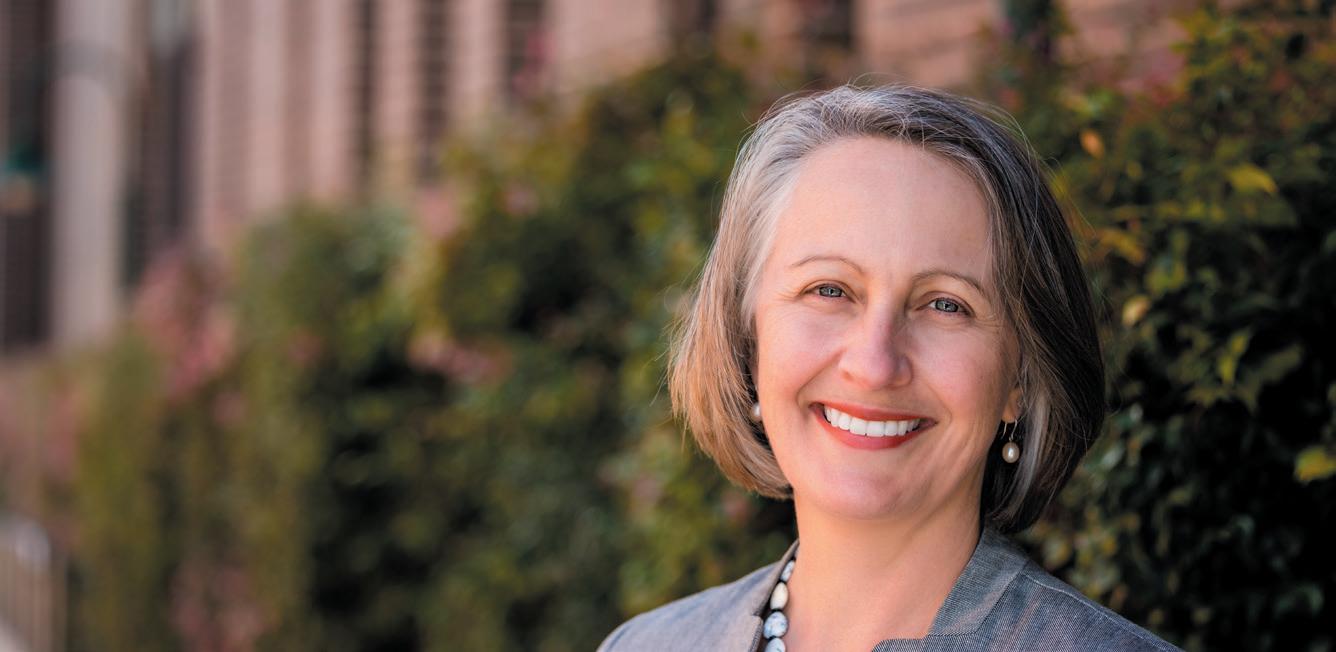
Welcome to the latest edition of Illuminate: Research and Innovation, the research journal of Pymble Ladies’ College. This edition is a cause for celebration as it is our 10th edition and we can look back on the research-focused educational stories we have shared over the past six years.
Our focus for this issue is Social Intelligence, one of the College’s four strategic pillars, which appropriately for an anniversary edition, highlights interrelatedness and connections between people. The main tenet of the Social Intelligence pillar is that through seeking and embracing diversity, including diversity of thought and background, a community comes together with a stronger sense of purpose. The articles in this edition continue the College’s story of the impact we can have in the educational landscape of Australia and beyond through bringing our diverse interests to the fore.
In the following pages, you will find research that takes you inside our commitment to the power of learning and teaching in the social, relational and intrapersonal domain. Following completion of her Global Action Research Collaborative research project with colleagues from the International Coalition of Girls’ Schools, Kate Giles shares her paper on fostering social and emotional learning among Junior School girls. Kate Brown, Head of Junior School looks strategically at the progress of the Junior School’s kindness initiative and evaluates its growing impact on students. Similar threads are explored by Imogen Kennett, who utilises positive experiences in a reading aloud initiative to investigate ways of expanding literacy skills in young children, and Melinda Pedavoli writes about encouraging interdisciplinary ways of teaching to prepare our students for complex future contexts.
Authors have also interrogated some of the many and varied professional learning environments and opportunities available in our profession. Writing with the Pymble Institute team, Dr Meera Varadharajan shares her research into career change teachers. These are people who opted to re-train as teachers following a career which
began in a different domain. Dr Joshua McDermott and I present a literature review conducted on kindness and prosocial behaviours, and take a step back to explain the wider relevance of using literature reviews in a school improvement context.
Leadership is also in the spotlight, with Tom Riley and Vanessa Petersen reflecting on key opportunities that have enriched their perspectives on their roles. Tom participated in the Flagship Leadership Program with the Association of Independent Schools (NSW) and Vanessa presented at an international outdoor education conference in Tokyo, Japan with academics from Western Sydney University. Carolyn Burgess, Pymble’s Head of Boarding, reflects on the experiences gained during an overseas tour of boarding schools which afforded her the opportunity to recognise the important cultures and traditions that build effective boarding environments.
As you read, consider the highly relational, interconnected and complex work being undertaken each day in schools around the world. These articles are examples of some Pymble stories which we hope will inspire and inform others in their search for diversity of thought and action. Together, this collection of articles and the authors behind each initiative and paper, seek to embody the change we aspire to see in the world — one story, one research project, and one learning experience at a time. The authors and I hope you enjoy the papers which make up our tenth edition!
DR SARAH LOCH PhD, MEdSt, MTeach, BA, HFTGN DIRECTOR – PYMBLE INSTITUTE


Victoria Adamovich moved from Taipei to London at the age of eight and studied French and Politics at The University of Edinburgh. After working for a decade as a marketing executive in Asia, she retrained as a teacher at the University of Hong Kong. She taught in bilingual EnglishChinese schools in Hong Kong and Shanghai before returning with her family to Sydney in 2017 to work at Pymble Ladies College as an EAL/D teacher. To better understand the students and families she supports; Victoria embarked on a Master of Research at University Technology Sydney to study the wellbeing of migrant children. Victoria also works as the Research Associate with the Pymble Institute and she has also authored a children’s picture book, The Story of My Names
Kate Brown has been teaching across Kindergarten to Year 8 for more than thirteen years, since changing careers from law to education. In her career as an educator, Kate has been a class teacher, Year Co-ordinator, K-6 English Co-ordinator, Deputy Head of Learning and Head of Student Wellbeing K-6. Her approach to teaching and learning centres around the philosophy that creating a culture of kindness provides an environment in which each child feels happy to be who they are and, therefore, ready to learn and ready to embrace challenge, as well as learning. This enables Kate to inspire Pymble students to be kind, not only to themselves, but to then share their ideas with others and positively impact their world.



Carolyn Burgess is a dedicated educator with over 30 years of experience shaping young minds and fostering educational growth. For the past seven years, she has served as the Director of Boarding at Pymble Ladies’ College, where she passionately invests in creating a supportive and enriching environment for boarders. Carolyn is deeply committed to community life and continually strives to provide the best possible opportunities for our boarders, ensuring they thrive both academically and personally.
Kate Giles is the Head of Wellbeing K-6 at Pymble Ladies’ College. With a background in primary teaching and law, Kate has worked in both government and independent schools, predominantly in girls’ education. Prior to moving to education, Kate practised as a professional indemnity litigator in health law. She also holds qualifications in psychology. Kate is currently undertaking a Master of Education with a specialisation in student wellbeing. Kate is passionate about personalised learning and the importance of student wellbeing. She is currently undertaking action research projects on student wellbeing in the primary classroom.
Imogen Kennett is a Grade Co-ordinator and Compass Teacher in the Junior School at Pymble Ladies’ College. With a background in primary teaching, Imogen has worked in both government and independent schools. She is passionate about student wellbeing and dedicated to enhancing student learning and engagement. Imogen’s experience in various educational settings has equipped her with a deep understanding and commitment to fostering a supportive and stimulating learning environment, ensuring that every student thrives both academically and personally.

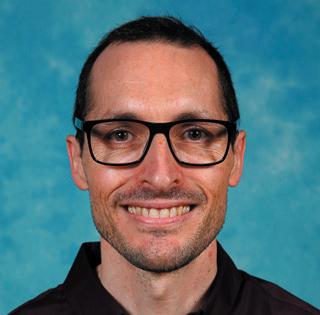
Sarah Loch is the founding Director of the Pymble Institute at Pymble Ladies’ College, the school’s hub of researchrelated activities. She works with students, staff and alumni, along with academics and partners from external organisations, to create opportunities for research. Sarah gained her PhD in education with a thesis examining ways young adolescent girls select school subjects and plan for their futures. She teaches History, where she loves helping her students develop a passion for scholarship. She leads the College’s Social Intelligence strategic pillar and is responsible for the College Libraries, Archives, Social Impact and Careers programs.
Joshua McDermott has been teaching History and English for more than fifteen years for a diverse range of students in Korea, London Melbourne and Sydney. It was as the Head of History at St Thomas More in London that he gained a keener sense of the need for holistic responses to the social, psychological and emotional needs of students. He found that schools can support students in not only reaching their academic goals, but also in finding their passions. His postgraduate journey in research began at Macquarie University with a Master of Arts and a Master of Research before he completed his Doctorate summa cum laude in Ancient History at the University of Sydney. He currently teaches History and performs research at Pymble Ladies’ College, a place which nurtures students’ individual learning journeys.
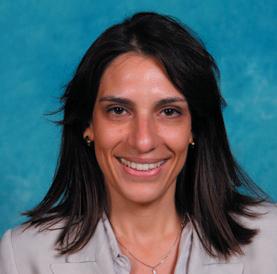
Melinda Pedavoli is the Head of Drama and Theatre Production at Pymble Ladies’ College, having previously served as Head of Teacher Development and Head of English at St Catherine’s Sydney. With sixteen years’ teaching experience, Melinda has consistently demonstrated her ability to drive educational change through an innovative and practicebased approach to pedagogy. Her leadership has fostered a culture of lifelong learning, achieving significant growth and success across the teams she has led. Holding a Bachelor of Education with First Class Honours and the University Medal from Sydney University, and a Master of Educational Learning and Leadership from UTS, her strengths lie in empowering and developing others, championing best practices, and fostering positive school-wide change in response to the evolving educational landscape.


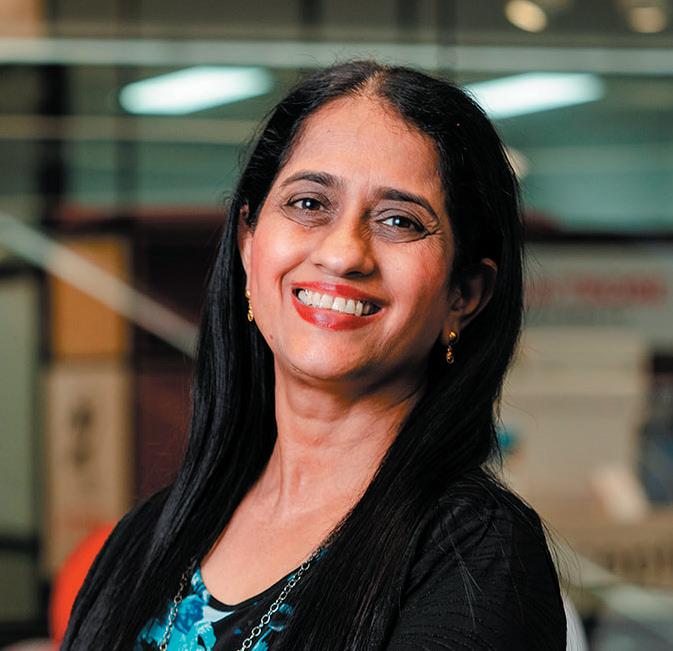
Vanessa Petersen is a passionate and innovative educator. Graduating at the top of her course with First Class Honours from the University of Sydney, and has consistently demonstrated her creativity and leadership in teaching. Vanessa’s teaching experience began with HSC and IB Science (Biology and Chemistry), before pioneering STEM and integrated learning initiatives across tertiary, secondary and primary education institutions. Vanessa has held leadership roles in curriculum, pastoral care, and more recently in the unique learning environment of Vision Valley, Pymble’s second campus in Arcadia, NSW. Her pursuit of excellence spans beyond the traditional classroom to ignite courageous and adventurous young adults.
Tom Riley is the Head of Campus - Vision Valley and was previously Head of Upper School at Pymble Ladies’ College. He grew up in the United Kingdom in a family of teachers and attended boarding school before moving to Australia for university. He began teaching Biology and has since held leadership roles in pastoral care, academia, and outdoor education, both in Sydney and regional Australia. With a Master’s degree in Organisational Learning from Monash University, Tom believes education fosters progress and connection. He is passionate about inspiring curiosity and aligns with Pymble’s mission to empower young women.
Meera Varadharajan is a Senior Research Fellow at La Trobe University in Victoria. She is Research Lead of the Commonwealthsupported award-winning Nexus Program - an innovative employment-based pathway to join the teaching profession. Meera has over 15 years of experience in the education field. She is an experienced qualitative researcher, and her research focus and expertise are in the areas of education equity; education policies impacting schools; teacher retention and career change professionals. Prior to joining La Trobe in March 2024, Meera worked at the University of New South Wales for five years as a Research Fellow at the Centre for Social Impact (CSI) where she was involved in leading and managing complex research projects and programs. Meera is passionate about connecting human stories and experiences in her work to drive purposeful change in society.

Kate Giles, Head of Wellbeing K-6, Pymble Ladies’ College
The COVID-19 pandemic impacted the social and emotional learning skill development of many students, and addressing the adverse effect of distance learning and the limited social interactions has been recognised as a priority in education (Reimers et al., 2023). Social and emotional skills are vital to student wellbeing, particularly for girls (Kuriloff et al., 2017), and research has demonstrated the significant relationship between student wellbeing and academic outcomes (Fitzpatrick & Page, 2022). This finding has made the teaching of social and emotional skills a priority
in education generally and is a specific focus in the Junior School at Pymble Ladies’ College.
The influence of key adult figures at home and at school has been shown (Howard et al., 2017) to shape children’s social and emotional development. It is suggested that the creation of consistent environments both at home and school, where parents, teachers, and students work together to build a shared language and understanding of social and emotional skills will aid in the growth and development of those skills. When looking at the Global Action
Research Collaborative (GARC) action research topic of collaboration, I reflected on what this meant when teaching social and emotional skills, and my focus became the issue of how to build this shared language and understanding through collaboration. This led me to my research question: How does active collaboration in Compass Directions lessons strengthen girls’ social and emotional skills?
Action research enables educators to undertake a systematic inquiry into their own practice (Mertler, 2020) to improve and refine their
teaching. Utilising an action-research methodology for this project allowed me to create a series of interventions, based on research, where the girls collaborated with each other and their parents to explore different strategies for selfmanagement and self-awareness. Using this methodology allowed me to focus specifically on how social and emotional skills are taught to the girls in Year 3 and provided the opportunity to systematically implement and evaluate the effectiveness of these interventions for developing these skills.
Considerable research emphasises the positive impact of social and emotional skill development on student outcomes, demonstrating that effective social and emotional learning programs enhance academic performance (Dix et al., 2020; Durlak et al., 2011; Greenberg et al., 2017; Paige, 2021; Wong et al., 2018). Cipriano et al. (2023) extend this body of evidence, showing improvements in behaviour, peer relationships and academic achievement through such interventions. Notably, Fitzpatrick et al. (2022) emphasise that this is particularly important for girls.
The CASEL (Collaborative for Academic, Social and Emotional Learning) Framework (2012) takes a systemic approach across several key settings (classrooms, schools, families and communities) to enhance social, emotional and academic learning. Key social and emotional competencies identified by CASEL include selfmanagement and self-awareness. The development of these skills is particularly important for girls, who have been shown to have difficulty
expressing and regulating emotions, building resilience, and, therefore, have a greater rate of anxiety symptoms (Australia Ministerial Council on Education, Employment, Training and Youth Affairs (MCEETYA), 2008). The World Health Organisation (2000) further identifies coping and self-management skills – skills for managing feelings and skills for managing stress – as being essential for the healthy development of children and adolescents. These two areas, self-management and self-awareness, were identified by the Year 3 teachers at my school as areas in which the girls needed further development, so these became the focus for this research project.
Albright and Weisberg (2010) suggest that evidence-based social and emotional learning programs are more effective when they extend into children’s home lives. This notion is confirmed by Dent (2022), who states the importance of parents being involved in their daughters’ social and emotional learning, as well as the need to help girls to understand their own emotions and the emotions of others to successfully navigate relationships. Dent further articulates this importance for girls in particular: “Helping our little girls identify when they are feeling stuck in a mood and helping them work out ways that they can escape the mood, is a really helpful life skill’ (p.84).
Research further demonstrates that collaborative learning, where groups of learners work together to solve a problem, complete a task, or create a product, has major benefits, particularly for girls (Griffiths et al., 2020). These benefits include social benefits, such as the establishment of shared understanding and learning
communities; psychological benefits, such as a reduction in anxiety; and academic benefits, such as the promotion of critical thinking skills (Laal & Ghodsi, 2012). Tolmie et al., (2010) take this concept further, indicating that collaborative learning in primary school students not only builds understanding of a given topic, but also provides powerful social effects by improving social skills in students. In the classroom, collaborative lessons, activities and projects provide girls the opportunity to take responsibility for their learning and foster conditions where girls can confidently share understanding and express their ideas without fear of damaging their relationships. It is these relationships that not only help learning but also provide skills development for positive peer interactions (Roffey, 2011).
One strategy that has been used to develop social and emotional learning in the primary school classroom is Circles (also referred to as Circle Time) (Mosley, 2009). This strategy involves the teacher being more of a facilitator once the circle structure and agreed norms are established. Here, the students collaborate within that safe structure, listening to each other, appreciating each other’s perspectives and collaboratively problem-solving together. Visible thinking routines (Richhart & Perkins, 2008), such as “Think, Pair, Share,” are also effective collaborative strategies that can be utilised to explore and deepen thinking and understanding around topics. Teaching girls how to collaborate can also aid the development of important skills such as cooperation, positive interdependence, and peer relationships (Laal, 2013).
In addition to collaboration between students in the classroom, collaborating with families has been shown to be a key factor in determining school success, both academically, socially and emotionally for students and that these partnerships, if effective, also provide significant protective factors to support student mental health:
Schools play a vital role in promoting the intellectual, physical, social, emotional, moral, spiritual and aesthetic development and wellbeing of young Australians, and in ensuring the nation’s ongoing economic prosperity and social cohesion. Schools share this responsibility with students, parents, carers, families. (MCEETYA, 2008, p. 4).
It is the importance of creating a consistent supportive environment, both at school and at home, to support the development of girls’ social and emotional skills that this project sought to explore. The continued development of girls’ social and emotional skills is essential, particularly following the COVID-19 pandemic. These skills underpin effective learning, enabling emotional regulation, problem solving, and positive peer relationships (Durlak et al., 2011). By fostering collaboration between students and between students, teachers, and families, a consistent environment and shared responsibility for social and emotional development can be established (Byrne et al., 2020).
Pymble Ladies’ College, situated in Sydney, Australia, is an independent school catering to girls from Kindergarten to Year 12 (ages five to 18 years old). The Junior School encompasses over 800 students,
including 125 girls in Year 3. This research involved a Year 3 class of 22 students, aged eight and nine years-old, and was undertaken from August to December. I conducted two (sometimes three) hour-long afternoon sessions per week, integrating the project into existing Compass Directions lessons to avoid disrupting the curriculum and ensuring there was no disadvantage to the class. The class was selected due to my prior teaching experience with them in Year 2 and my current role overseeing student wellbeing in the Junior School. The impact of the COVID-19 pandemic on the year group’s wellbeing and social-emotional development also influenced the selection.
Participation in the research project was optional; however, all students in the class participated in the lessons. Parents provided consent for their daughter to be involved in the project, and were sent communications containing information about the project, including how to withdraw their daughter at any time during the project. In addition, the girls were informed of the project, what was involved, and that their participation was voluntary. Parents were separately asked to provide consent for the girls to be photographed and videoed during lessons and interviews and, to ensure anonymity, all names have been omitted from this report.
The main action of this project was to facilitate the development of selfmanagement and self-awareness skills in the girls. The initial plan was to create a series of lessons where the students collaborated with each other to learn a variety of techniques to regulate their emotions. It was then planned that the students would share
these strategies with their families at home on the basis that, to ensure the development of social and emotional skills, there needs to be consistency between the home and school environments (Griffiths et al., 2020).
It was explained to the girls that they would participate in lessons where they learnt and explored different strategies and techniques that they could use to regulate and manage their emotions. The collaborative nature of the lessons was explained to the girls, where they would explore and practice the techniques together, discuss and share their thoughts, and reflect as a class. The project started with some explicit lessons on collaboration, building trust, and understanding active listening, before moving on to selfawareness and self-management skills. Each lesson had a specific focus and included activities, such as reading picture books, role plays, learning a specific skill such as belly breathing, discussions, brainstorming, and reflecting. Each lesson started with the girls seated in a circle on the floor. I also sat within the circle with the students to create a feeling of equality, teamwork, and collaboration (Roffey, 2011).
The action evolved over the course of the project following student opinions regarding some of the activities. For example, some of the mindful activities, such as colouring and meditation, evoked strong feelings from the girls, both positive and negative. This made me consider how personal it was when determining what techniques and strategies worked to manage our own emotions and I decided that it did not seem appropriate to simply expect the students to all use the same techniques and strategies. Consequently, I added an extra step
to the action whereby the lessons would culminate in the creation of personal toolkit (see Figure 1’) by each student that she could then use when needed.
The project started in August 2023 and, over the course of approximately 12 weeks, the students worked together to explore various social and emotional learning skills to develop their self-regulation and self-management. During this time, I collected both qualitative and quantitative data through a mixedmethods approach. This allowed polyangulation of findings and enhanced their validity, with the aim to create a data set that was credible, accurate and dependable (Mertler, 2020). I used a variety of different data collection techniques, including:
• questionnaires for students, teachers and parents;
• individual student interviews;
• focus groups of parents;
• researcher observations and field notes;
• student work samples;
• student self-reflections (videos).
I first collected data about the social and emotional skill development of the Year 3 girls, as observed by their teachers. This was collected via questionnaire, and I asked questions (using a five-point Likert scale) such as, ‘The Year 3 girls are able to regulate their emotions’ and ‘The Year 3 girls have tools and strategies they call upon to help regulate their emotions when needed’.
Following this, I also conducted a baseline questionnaire with the parents, seeking to understand their awareness of the social and emotional skills their daughter is taught at school and their role in their daughter’s social and emotional skill development. This information was used to inform the action that I was going to take in the project and assisted in providing part of the baseline data for the intervention. The same questionnaires were provided at the end of the project to both parents and teachers.
During the lessons, additional data were collected from student discussions, brainstorming using

butcher’s paper and post-it notes, and observational notes. Photographs and videos were also taken. It was during these lessons, that I recorded my observations using field notes on the discussions and responses to activities, as well as my observations about the collaboration between the girls. In addition, the girls also completed a questionnaire to share their views of the lessons at the half-way point of the intervention. This was to provide feedback about the different interventions and activities, and served to seek feedback from the quieter students who may have been uncomfortable providing their insights verbally.
The students completed a selfreflection each week, which not only asked them to reflect upon the specific social and emotional skills learned that week, but also to reflect on their collaboration with their peers and family. This self-reflection allowed me to understand “students’ daily thoughts, perceptions and experiences in the classroom” (Mertler, 2020, p.138). This reflection was also useful in determining how much the students collaborated with their peers and families on these activities and it captured their thoughts and opinions regarding this collaboration. (See Figure 2 for examples of selfreflection done by students).
Another key part of the data collection process was the focus group interviews with students and with parents. The interviews with the girls were conducted in small groups of three or four, and included some prepared questions for consistency, but also allowed the girls to provide their own thoughts and insights, while providing me with the opportunity to ask any follow-up
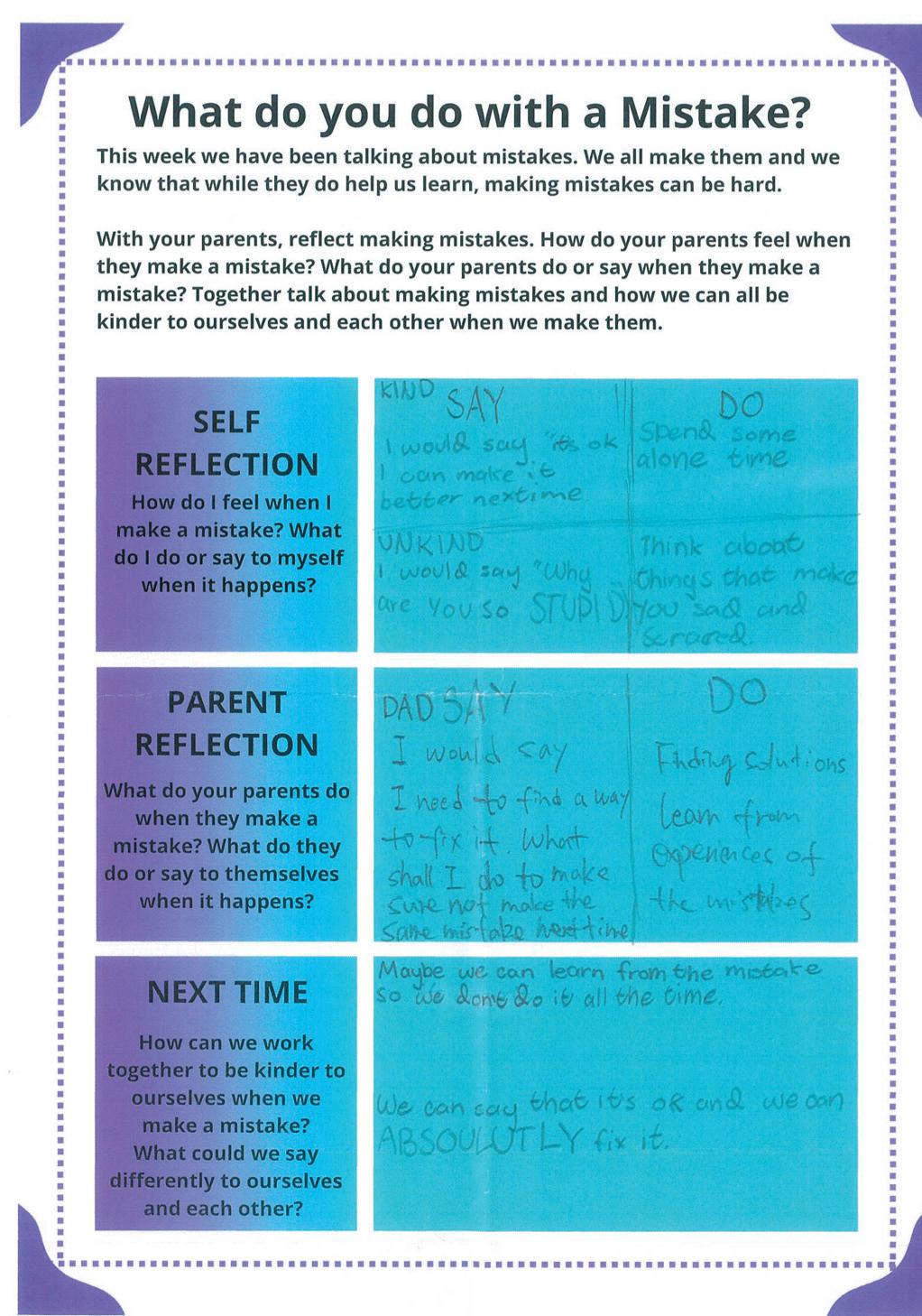


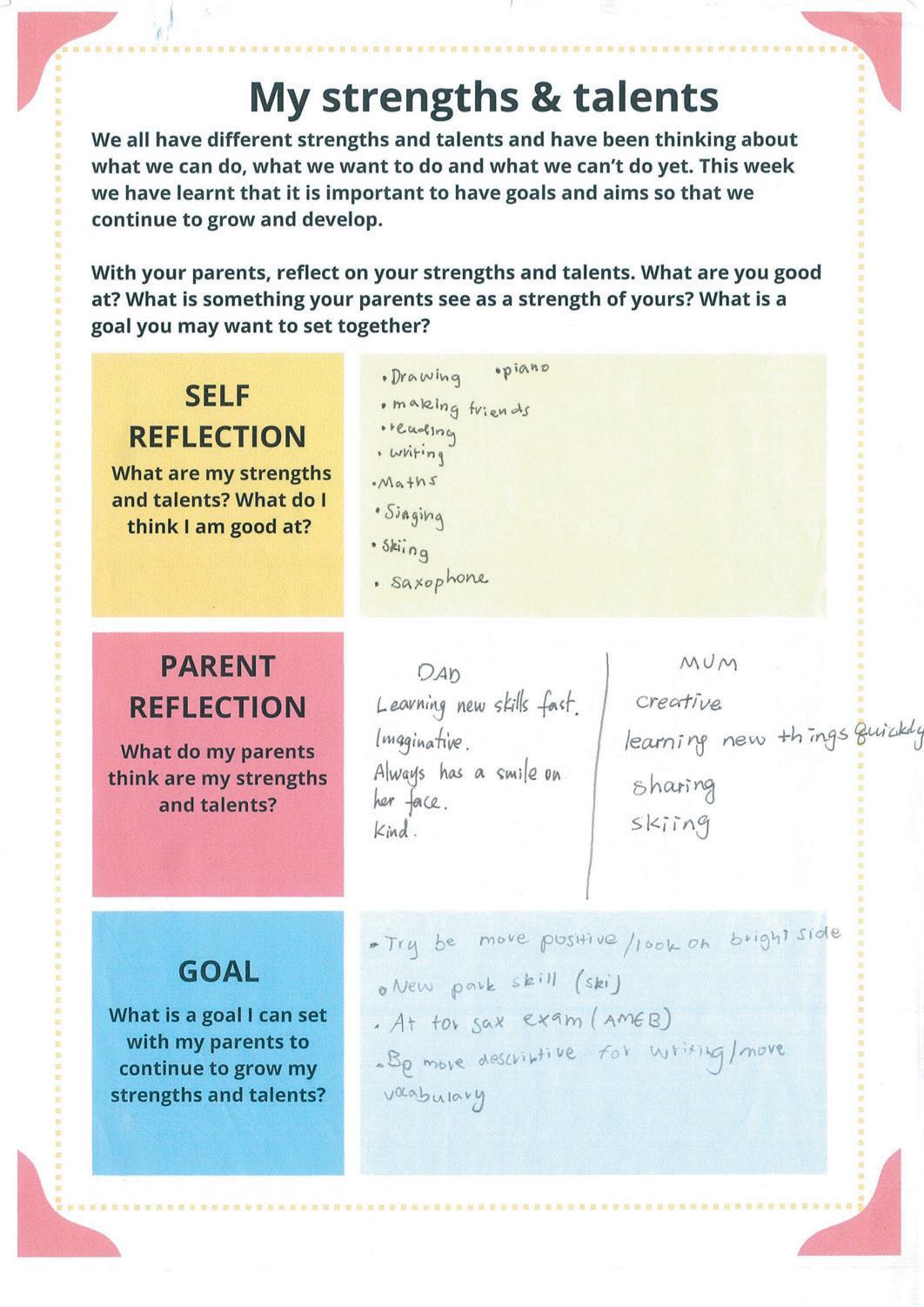
questions as needed. These semistructured interviews (Mertler, 2020) focused on the activities in the lessons to develop self-regulation and self-management, plus sought the girls’ views on collaborating with their peers and families on the activities. The interviews with parents were beyond the scope of this research project and will be explored further at another time. Memberchecking and peer debriefing (Mertler, 2020) were also used as there was always a second teacher in the classroom during the intervention lessons. Following each lesson, time was taken to discuss the observations made and discuss thoughts about the activities. This was a useful step to ensure the accuracy of the data collected in the lessons.
The collection of a wide range of data before, during and after the intervention lessons in the project helped ensure that the results obtained about any change were clear and trustworthy. Once all data had been collected, I followed the process of inductive analysis to determine patterns and themes to make sense of the data (Mertler, 2020). This was completed by first transcribing any video interviews, merging and sorting the girls’ reflections, my field and observational notes, and the questionnaire results. I developed a coding system to assist processing and collating the data to make connections between the data and the research question and to
articulate findings and determine overarching themes.
Initial analysis of the data identified some clear themes, which were used to further analyse and distil my ideas. These themes and patterns were directly linked with my research question and supported my idea that active collaboration between the girls, their teachers and parents to create a personalised tool kit to support emotional regulation would benefit the girls’ development of social and emotional skills. Although there will be further work undertaken on this project, specifically related to the parental involvement, from this analysis, the following themes were identified:
“Joyful Learning” – Collaboration encourages high student engagement
The engagement of the students was essential for the project to be successful, given the personal nature of the lessons. Cooperative and collaborative learning has been shown to be important to aid the development of social and emotional skills by helping foster and build greater student engagement (Dyson et al., 2020). Further, Abla and Fraumeni (2020), reinforce the importance of student engagement with their learning, including social and emotional learning, for their long term physical and mental development. My initial observations of the girls were that, as soon as they saw me in their classroom as
they came in (lessons were held after lunch), they were extremely excited and immediately sat in the circular formation on the floor ready to start the lesson. This indicated a high level of engagement.
It was also clear from the interviews, self-reflections and surveys that the girls’ engagement with the lessons and the content was high:
“My favourite time of the week is these lessons as I like talking to the class and sharing my ideas and the activities are really fun” (Student D). The initial lessons set up the plan for the project and explored what collaboration looked like with the girls. Initially there was some trepidation from some of the girls when the concept of collaboration in relation to social and emotional learning was discussed. Some girls later commented that they felt nervous sharing their inner feelings with their classmates, with Student A saying, “At first I was really worried that if I shared how I felt about something people may not be nice to me. Normally I only share my feelings with my family and maybe some best friends, not the whole class.” The initial reservations from this student were alleviated, as her later reflections showed: “This has helped me, like, say my feelings out. Before I wouldn’t really say them out loud and people wouldn’t know what I’d be feeling like, but now they do.”
There were many joys during the
“There were many joys during the project, including hearing the girls talk about their toolkit with pride and an understanding of themselves, witnessing the growing trust in the classroom between the girls and hearing from the teachers that they had seen a change in the girls’ emotional regulation when using their toolkit strategies.”
project, including hearing the girls talk about their toolkit with pride and an understanding of themselves, witnessing the growing trust in the classroom between the girls and hearing from the teachers that they had seen a change in the girls’ emotional regulation when using their toolkit strategies. The highlight, however, was hearing from the girls each Monday after they had shared their learning and reflections with their parents. One lesson, in particular, will stand out in my mind forever. This lesson followed the girls sharing and reflecting with their parents about their strengths and talents and setting some goals for themselves together. The girls were bursting with excitement to share their parents’ thoughts about their strengths and talents, some getting tearful sharing with pride what their parents had said about them and their strengths. Seeing the impact of the connections and trust grow between the girls and between the girls and their parents was something I had not really considered.
A safe classroom environment facilitates collaboration
When introducing the project to the girls, the creation of a safe environment in which they could share their personal feelings and thoughts was essential. We initially discussed what good collaborative learning looked like and the girls explained how the establishment of trust and respect is needed to facilitate cooperation and collaboration. As indicated by Griffiths et al., (2020), there are eight constructs identified that lead to collaboration, including trust, mutual respect, shared goals, and shared responsibility. It was clear throughout the project that Year 3 classroom had been created to be a safe space
for students to build trust and their mutual respect was reflected in their honest and vulnerable shared reflections. Student A commented, “My favourite thing about sharing with my friends is being able to get feedback and you can then improve and change your ideas. I liked how my friends were honest with me about how I could change things.” While Student D noted, “You get to spend more time with your classmates and can explain and understand more of what they are saying, and it helps to understand how they are really feeling.”
In addition, the girls expressed that they felt they had developed stronger connections with each other in the classroom through collaborating in the lessons. One of the girls reflected that this connection helped prevent some friendship conflict, too: “My favourite part of working together in Compass Directions is we can find out how each other feels and so we can understand each other more instead of having friendship fires” (Student C).
The girls showed maturity and honesty when reflecting with me during their interviews, noting the challenges of collaboration: “Sometimes it is tricky when we disagree as we then have a bigger challenge to overcome” (Student E), and “Working with other people can sometimes be hard as I don’t want anyone to get left out when they need a partner for discussion” (Student C). Student B also remarked, “Sometimes I feel uncomfortable talking in groups and sometimes I don’t really understand what they are talking about.”
A positive comment came from a student who initially found it really
challenging to share her thoughts and feelings with the class, her teachers and parents. Initially, she preferred to observe and listen, and only occasionally contributed to the group work when it involved writing things on post-it notes or the whiteboard. In her final interview with me, when she was reflecting on the tool kit she had made and how she felt, she said, “It is hard sharing our feelings with each other to start with but it got easier” (Student G).
Personalised management strategies enhance student agency Given the personal nature of the content of the lessons, and the need for students to connect with the strategies and activities to incorporate them into their routine to regulate and manage their emotions, it was vital that the girls collaborated when learning the tools and strategies to build their social and emotional skills. Such connection would able them to take ownership and have voice and choice when selecting the inclusions within their toolkit. The enablement of student agency is supported by the literature in the area, where students are empowered through the opportunity for voice in their learning and where learner voice and reflection positively impact learning (Landis et al., 2015).
Agency was demonstrated in the interviews with the girls during the creation of the toolkits and when the girls shared their toolkits with me. Student E commented, “I liked making my toolkit so I could think about the things that worked for me … some were different to my friends, and some were the same as my friends,” and Student A said, “It was funny that my friends really hated mindful colouring and drawing to help them calm down so they did
not use it in their toolkit but I have it in mine.” This ownership led to the girls being able to utilise these skills during times of emotional dysregulation, both at home and in the classroom or playground: “Yesterday I used my toolkit when I had a friendship fire with my friend. I got upset and angry and then I remembered the toolkit, so I did some belly breathing and read my positive affirmation. This helped me calm down and then talk it out” (Student D).
Although not part of this report, the development of the girls’ agency was further confirmed through parent and teacher interviews, where the parents and teachers noted the use of the specific strategies by the girls from their toolkits were positively impacting their emotional regulation in the classroom and at home.
Collaboration beyond the classroom enhances family connections
During the interviews and discussions with the girls, a clear theme emerged regarding the collaborative homework with their parents. The girls indicated, almost universally, that having personal homework to do with their parents, that involved discussions and joint input and output, meant greater connection time with their parents. Student F expressed, “I enjoyed that we were able to interact and share together, and my parents helped me to think about the activities and understand myself more.” Student B commented, “I liked listening to my parents and combining our ideas, but I was really surprised by what my mum wrote down about me (my strengths and talents). I didn’t know the things until we did the activity together” (See Figure 3 for an example of self-
reflection on strengths).
Although connecting with parents was a very positive result, as the girls loved this time, some of the girls were challenged by this collaboration, as it was not something that they had done before and was difficult for parents to fit into already busy schedules: “It is sometimes hard asking my parents for help and to work on things with me as they are busy” (Student C). This is a potential difficulty of any such collaboration and one that would need to be considered should this format be continued. Another challenge the girls expressed was being open and vulnerable with their parents about their emotions: “Something challenging was I was a bit scared to share my emotions with my parents but using the reflections and the toolkit helped me share with them” (Student G).
At the completion of the project, the girls asked if they could do something similar in Year 4. When I asked why, they expressed that it was lots of fun and helpful working with their friends and their parents about their feelings: “I really liked talking with both my friends and family about my feelings and I love how the homework is actually something that can help you. I really think working on these activities together made me understand my friends better, too” (Student F).
The development of selfmanagement and self-awareness skills in girls is a complex and ongoing process. As research has shown, long-term universal programs and interventions targeting these skills are needed to ensure these skills are embedded. The findings
from this action research project confirm that explicit teaching of these skills along with collaboration between the girls and their peers, as well as the girls and their families, creates an environment of shared understanding and trust. The girls were able to create their own personalised tool kit to assist them with emotional regulation by reflecting together and teaching these skills to their families. The teachers and the girls’ parents indicated improved self-management and self-awareness skills in the girls, particularly when managing feelings around making mistakes and friendship conflict, and it was clear that there was some consistent benefit in having strategies and activities across both the home and school environments that the girls could use.
The positive impact of this intervention was clear; however, it also had limitations. One was the difficulty managing the collaboration between the girls and their parents, given this happened at home. Some girls reported that the time needed to share their learning and reflect with their parents was difficult to find each week, which meant that the collaboration between the girls and their parents was not equal for each girl. Another limitation was the difficulty in seeing improvement in the girls’ self-management and self-awareness skills over the short period of the project, particularly as they moved into a new grade at the start of the year. It would be interesting to continue to track the girls over a longer period to see the true significance of this intervention. Finally, a third limitation of the project was the time available to implement the project given the need to fit in with the other timetabled lessons of
the teacher so as not to disadvantage the girls in any way.
A future direction for research in this area is to explore how to strengthen
the consistency across home and school environments in social and emotional skill development and I will be utilising data collected from parents here as a starting point to
References
Albright, M. I., & Weissberg, R. P. (2010). School-family partnerships to promote social and emotional learning. In S. L. Christenson, & A. L. Reschly (Eds.), Handbook of school- family partnerships for promoting student competence (pp. 246–265). Routledge.
Australia Ministerial Council on Education, Employment, Training and Youth Affairs (MCEETYA). (2008). Melbourne Declaration on Educational Goals for Young Australians
Byrne, D., Carthy, A., & McGilloway, S. (2020). A review of the role of school-related factors in the promotion of student social and emotional wellbeing at post-primary level. Irish Educational Studies, 39(4), 439–455.
Cipriano, C., Strambler, M. J., Naples, L., Ha, C., Kirk, M. A., Wood, M. E., Sehgal, K., Zieher, A. K., Eveleigh, A., McCarthy, M. F., Funaro, M. C., Ponnock, A., Chow, J., & Durlak, J. (2023). Stage 2 report: The state of the evidence for social and emotional learning: a contemporary meta- analysis of universal school-based SEL interventions https://doi.org/10.31219/osf.io/mk35u
Collaborative for Academic, Social and Emotional Learning (CASEL) (2012). Effective social and emotional learning programs: Preschool and elementary school edition. CASEL Guide.
Dix, K., Ahmed, S. K., Carslake, T., Sniedze-Gregory, S., O’Grady, E., & Trevitt, J. (2020). Student health and wellbeing: A systematic review of intervention research examining effective student wellbeing in schools and their academic outcomes. Main report and executive summary. Evidence for Learning, Melbourne.
Durlak, J. A., Weissberg, R. P., Dymnicki, A. B., Taylor, R. D., & Schellinger, K. B. (2011). The impact of enhancing students’ social and emotional learning: A meta-analysis of school-based Universal Interventions. Child Development, 82(1), 405–432. https://doi. org/10.1111/j.1467-8624.2010.01564.x
Fitzpatrick, R. & Page, E. (2022). The connection between socioemotional learning and girls’ educational outcomes. K4D Helpdesk Report. Institute of Development Studies.
Greenberg, M.T., Domitrovich, C.E., Weissberg, R.P. & Durlak, J.A., (2017). Social and emotional learning as a public health approach to education. The Future of Children, 27(1),13–32.
Griffiths, A.-J., Alsip, J., Hart, S. R., Round, R. L., & Brady, J. (2020). Together we can do so much: A systematic review and conceptual framework of collaboration in schools. Canadian Journal of School Psychology, 36(1), 59–85. https://doi.org/10.1177/0829573520915368
Howard, C., Burton, M., Levermore, D., & Barrell, R. (2017). Children’s Mental Health & emotional well-being in primary schools. Learning Matters, an imprint of SAGE Publications Ltd.
build upon. I am also excited to explore how to implement this project or similar initiatives across other grades.
Kurilof, P., Andrus, S., & Jacobs, C. (2017). Teaching Girls: How Teachers and Parents can reach their brains and hearts. Rowman & Littlefield.
Laal, M. (2013). Positive interdependence in collaborative learning. Procedia-Social and Behavioral Sciences, 93, 1433–1437.
Laal, M., & Ghodsi, S. M. (2012). Benefits of collaborative learning. Procedia - Social and Behavioral Sciences, 31, 486–490. https://doi. org/10.1016/j.sbspro.2011.12.091
Landis, C. M., Scott, S. B., & Kahn, S. (2015). Examining the role of reflection in ePortfolios: A case study. International Journal of ePortfolio, 5(2), 107–121
Mertler, C.A. (2020). Action research: Improving schools and empowering educators (6th ed.). Sage Publishing.
Mosley, J. (2009). Circle time and socio-emotional competence in children and young people. In C. Cefai & P. Cooper (Eds.), Promoting emotional education: Engaging children and young people with social, emotional and behavioural difficulties. essay, J. Kingsley Publishers.
Paige, R. (2021). Creating a positive culture within primary schools: Whole school initiatives to foster effective social learning relationships. Social and Learning Relationships in Primary Schools, 73–92. https:// doi.org/10.5040/9781350096097.ch-004
Reimers, F. M., Bhuradia, A., Kenyon, C., Liu, Y. (Yoly), Nguyen, N., & Wang, M. (2023). Rebuilding resilient education systems after the COVID-19 pandemic. Creative Commons.
Ritchhart, R., & Perkins, D. (2008). Making thinking visible. Educational Leadership, 65 (5), 57–61.
Roffey, S. (2011). Introduction to positive relationships: Evidence-based practice across the world. Positive Relationships, 1–15. https://doi. org/10.1007/978-94-007-2147-0_1
Tolmie, A. K., Topping, K. J., Christie, D., Donaldson, C., Howe, C., Jessiman, E., Livingston, K., & Thurston, A. (2010). Social effects of collaborative learning in primary schools. Learning and Instruction 20(3), 177–191. https://doi.org/10.1016/j.learninstruc.2009.01.005
Wong, R.S.M., Ho, F.K.W., Wong, W.H.S. et al. (2018) Parental involvement in primary school education: Its relationship with children’s academic performance and psychosocial competence through engaging children with school. Journal of Child Family Studies, 27, 1544–1555.
World Health Organization. (2000). Local action: Creating health promoting schools. World Health Organization. https://www.who.int/ publications-detail-redirect/local-action-creating-health- promotingschools
By Dr Meera Varadharajan,
La Trobe University, formerly Centre for Social Impact, University of New South Wales
Additional content by Dr Sarah Loch and Victoria Adamovich (Pymble Institute)
Pymble Ladies’ College is committed to attracting excellent educators both into the College and the teaching profession generally. The need to attract people into teaching and encourage teachers to remain in the profession is increasingly urgent, with the Australian government identifying five key drivers: increasing the number of people who want to teach, strengthening initial teacher education, keeping the teachers we have, elevating the status of the profession and better understanding the needs of the teaching workforce (Education Council, 2020; National Teacher Education Workforce Plan, 2022).
To better understand the context of career-change teachers (those who elect to enter the teaching profession after first having a different career), we engaged an expert in the field to conduct a research project with a group of Pymble Ladies’ College staff who are career changers. Dr Meera Varadharajan is a Senior Research Fellow at La Trobe University. Previously, she was Research Fellow at the Centre for Social Impact (CSI), University of New South Wales (UNSW). This project was undertaken by Dr Varadharajan while she was at CSI and a report was submitted to the College in August 2023 (Varadharajan, 2023). This article summarises the report’s findings.
Dr Varadharajan has made a significant contribution to the understanding of career changers in the teaching profession. Her doctoral thesis and subsequent work focus on the contributions that career changers make to the teaching profession. Her book, Career Change Teachers Bringing Work and Life Experience to the Classroom (Varadharajan & Buchanan, 2021), provides practical recommendations to schools and jurisdictions on how best to leverage the skills and expertise brought by career changers. The book also serves as a useful guide to anyone contemplating a career change to teaching.
RESEARCH QUESTIONS UNDERLYING THE PROJECT
1. What motivates career-change teachers to make a career change into teaching?
2. What strengths and attributes do career-change teachers bring into the teaching profession from their past careers?
3. What steps can the education sector take to attract, engage and retain career-change teachers?
Project participants were six Pymble teachers who had a career in a different field before becoming a teacher and eventually joining Pymble. Participant details:
• Gender: One male and five female teachers
• Teaching level: Three in Junior School (Kindergarten to Year 6) and three in Secondary School (Year 7 to Year 12)
• Years teaching: Between five and 20 years
• Careers prior to teaching: Marketing, sales, accounting, research science and pharmaceuticals
Each participant was interviewed by Dr Sarah Loch (Director - Pymble Institute) or Kate Rimer (Chief People and Culture Officer). Five interviews were conducted face-to-face, on campus, in the interviewer’s office and one was held online.
Aligned with the research questions, participants were asked about their motivations for career change, strengths and attributes they brought to teaching, advice for prospective career changers and suggestions for the education sector on attracting and retaining this group of teachers in the profession. Interview data from all six participants were emailed to Dr Varadharajan in de-identified format. Participants had consented for their data to be provided to Dr Varadharajan for the purpose of analysis.
Dr Varadharajan utilised a thematic analysis approach to extract rich, meaningful interpretations from the interview data (Smith, Flowers, & Larkin, 2009), focused on participants’ everyday contextual lived experiences and circumstances.
Results examined the following four elements. Dr Varadharajan noted that results from this project aligned with previous research conducted in this area (for example, Varadharajan & Buchanan, 2021). Participant quotations are included where appropriate to highlight teachers’ voices.
1. Reasons for career change
2. Teachers’ strengths and attributes
3. Suggestions for prospective career-change teachers
4. Suggestions for education sector
KEY ASPECTS
Being ‘pulled’ to teaching
Four out of six participants were either intrinsically motivated due to personal values or had a longstanding aspiration to become a teacher.
Work-life balance
Four out of six participants also identified work-life balance as one of the reasons for changing careers to teaching. Out of the four, three also cited stress-related factors in their previous career which contributed to looking at other career options.
Influence of family and friends
Three participants spoke of the role that family and friends had on their career switch.
KEY ASPECTS
Theory-practice connections
Participants spoke of bringing practical, real-world knowledge from their previous careers. By using examples from their prior careers, they were able to make teaching more relevant and authentic for students. Theory-practice connections were particularly noticeable in the case of subjects like STEM and business.
Confidence and passion
Participants were passionate about their subject area and expressed desire to share their passion with students. They expressed confidence in transferring skills to extend student thinking and creativity.
PARTICIPANT QUOTES
“Education was valued and emphasised in the household, it was seen as a way of bettering yourself, becoming a better person and also increasing opportunities for betterment…”
“I had been working for about 10 years in marketing. The role had a lot of travelling so after I had my first child, we had to reevaluate how we wanted to be as a family. I talked to different people I knew and teaching came up.”
“…actually my mother’s ear was really in the back of my head saying, ‘You should be a teacher, you should be a teacher’”
PARTICIPANT QUOTES
“The way I teach a lot of my lessons is through stories and experiences. I have a bank of things that I can convey to students and really give it that real-world context”
“I’m passionate about science and STEM generally, but science in particular. I want to expose, particularly girls, to STEM early on so they don’t lose that love of it. You know, so they don’t gain that fear. That’s been a personal mission driven partly by my experience, but actually partly by life experience”
“…it also helps me to think about how I can extend students or get students to think about things differently…by introducing scenarios that I’ve actually been in or worked in. I find this can give them a different perspective when learning about these things”
Participants valued students’ diverse strengths and abilities and the importance of adapting or tailoring teaching practices to meet student needs.
Because of their wide career and life experiences, participants brought knowledge about workforce skills and a certain degree of maturity and wisdom to their teaching role. These attributes enabled them to build rapport and communicate effectively with parents and guide students on career paths and the type of skills required in the workforce.
“Recognise the perspective of others and that in teaching, all classes and all students are different and therefore there’s a real need to adopt teaching styles and pedagogy to those particular aspects; the differentiation aspect of teaching”
“I’m able to provide some informed commentary around what it is that employees are looking for in terms of the skill set in the 21st century. It’s never just facts or information that appeals to a prospective employer …. the importance of intellectual rigour. There is very much a need to deliver a more complete skill set. And I’m able to emphasise the importance of the soft skills, as well being able to deal with clients and colleagues”
“Leading a team, functioning within that team, opening lines of communication, those sorts of discussions that you have. Yes, absolutely. I’ve been able to transfer those”
KEY ASPECTS
Participants noted that prospective career changers must move to teaching for the right reasons (such as driven by passion and intrinsic motives) and must be aware of the potential implications of such a move, including impact on career trajectory or on family.
Visiting classrooms and getting as much exposure as possible to school and teaching environments prior to a career switch was also noted as a strategy in the transition and settling process. Aspects of autonomy and flexibility can work differently in the teaching profession and exposure to school environments can help career changers recognise and adapt to these differences.
PARTICIPANT QUOTES
“They [career changers] really do need to understand what’s going to drive them and what’s going to motivate them”
“If they could have real life experience and see if that’s something they want to do and really be sure that they want to work with children. Try it before you buy it”
“If you’ve had a lot of autonomy in your role, you’re going to lose some of that autonomy, and you’re going to have to be able to deal with that”
Be passionate about teaching and subject area
Participants noted the importance of being passionate about teaching and/or the subject matter which can also contribute to a smoother transition and better career preparedness.
Utilise past skills and experiences
Effectively drawing upon past skill sets in their teaching practices was also pointed out as a factor for career success and to be valued.
Implement mechanisms for recognising prior skills and experiences
Participants came to teaching with diverse skills and talents. They were keen for schools and the education sector to be aware of these skills so that they could be recognised and effectively utilised or tapped into.
“You need to have strength in developing rapport around engagement with students. It’s demonstrating a passion to them”
Make transition easier and smoother for career changers
Examples noted by participants included formally recognising prior qualifications so that they are able to obtain teaching credentials that match their expertise. They also called for the provision of tailored support, including mentors who are able to give targeted feedback. Making career-transition journeys smoother and simpler will help attract and retain more career changers into the profession.
“I’ve been able to look at all my previous jobs and think about the different skills that each job has, that has led to teaching. And I feel like teaching uses the most skills, not just one or two of them… I’ve landed in a place that actually values an awful lot of my skills”
“We all have a life outside of what we do here. Everyone has a story and it is important to be able to have the time and the space to actually get that story from them to tap into what their strengths and interests are”
“They [schools] should have career days or events where it’s like, you know, teachers from another life, something like that, just sharing that knowledge, not losing what they have, the skills that they gained in their previous lives”
“I would like for the department and the sector to recognise that while I may be a graduate teacher, I’m not a “new graduate”, and recognise that I’ve actually got more than that, that I came to teaching from an established career. I had to wait another five years to do my experienced-teacher accreditation [after gaining proficient teacher]”
“I had a very effective mentor with people … these are very experienced teachers that I almost piggybacked off for a good year or two. I was able to observe other teachers to a significant degree, and I was able to take a lot from that”
Compensate for financial and other loss of income
Career changers have given up on well-paying careers to take up teaching. Participants suggested that financial considerations should be prioritised if the teaching profession wants to attract and retain career changers.
Provide high-quality resources and a conducive work environment
Good teaching resources and a safe work environment was an important issue for participants who had worked in environments that were quite different to school workplaces.
Improve societal perceptions about teaching
Participants noted the importance of teachers being valued and respected by the broader community.
“Because I’m older and I’m not young, I didn’t have the luxury of living at home with Mum and Dad. I’m studying, but I still had a young family with three small children, and that was the challenge. If they want teachers to come into teaching from another industry, you need to make it easier”
“I could see it [lack of quality resources] being a problem in public schools in particular … I think that can lead to a sense of dissatisfaction with the role for those coming from a more comfortable and better-resourced corporate environment ... it certainly required a bit of a mind shift for me”
“We’re always battling as teachers… a lot has to do with society and what they believe we are as teachers. I think as teachers, we don’t have the respect that we used to”
INFORMED BY THE THEMATIC ANALYSIS OF RESULTS AS DISCUSSED ABOVE, DR VARADHARAJAN SUMMARISED THE KEY TAKEAWAYS AND NOTED SOME FINAL POINTS AS A WAY FORWARD IN THIS TOPIC:
The role of competent and well-qualified teachers, providing students with the right environment to thrive and succeed in learning and beyond, cannot be underestimated. As the data from this research project indicates, career-change teachers’ reasons for joining the teaching profession are typically driven by intrinsic motivation and a commitment for sharing knowledge gained through one’s career and life experiences. These teachers bring attributes of passion, creativity, maturity, flexibility and context awareness which are considered highly valuable in a classroom setting (Korthagen, 2004). Participants provided useful suggestions to prospective career changers. Having knowledge about the teaching profession and its various intricacies prior to entry would be invaluable to individuals before they make the decision to switch careers. The impact of such prior knowledge could be that they are less likely to experience a ‘culture shock’, are better prepared as a classroom teacher and more likely to remain in teaching.
As participants in this project alluded to, there is also a greater need for the education sector, including schools, to clearly understand career changers in the ways of their characteristics, contributions and unique needs. Innovative ways to make teaching attractive for career changers must be considered. Like other professional careers, teaching will need to be competitive if it is to attract and retain skilled personnel. Financial remuneration is important, but as participants noted, career changers’ expertise and experiences can be rewarded through other creative means. For instance, through leadership opportunities and having school events that celebrate their past career achievements and current contributions.
Students and the teaching profession stand to significantly benefit from career changers. By commissioning this research project and highlighting their contributions, Pymble Ladies’ College recognises career-change teachers to be game changers in our classrooms.
• Explain your reasons for the career change
• Communicate your passion for the subject and for student learning
• Explore chances for a school visit
• Ask about ways you can demonstrate your ability to work independently, flexibly and as part of a team
• Make sure you understand the teacher accreditation process in the school/system
• What opportunities will you have for professional learning?
• Schools are excited to bring the real world to students; highlight your experience and industry contacts by sharing how you can make connections between theory and practice.
TALK ABOUT TRANSFERABLE SKILLS FROM YOUR PREVIOUS
• Appreciate that your previous career has gifted you a mature mindset
• Give examples of your people and communication skills
• Discuss the leadership and project management skills you have acquired and give transferable examples in the school context
• Career-change teachers have often made a decision to move into teaching because of a passion for the subject and working with students.
• Ask the candidate about their subject knowledge, how it has been gained and why the candidate has chosen to apply their skills to teaching children
SHOW RESPECT FOR THEIR INDUSTRY KNOWLEDGE
Career-change teachers may have had years, or even decades, of experience in another industry. It is important to give them time to talk to this prior experience. This demonstrates respect for their previous career/s.
• Can you provide opportunities for a school visit for the candidate to see one of your classrooms in action?
• How will you ask the candidate about the degree of autonomy they enjoyed in their previous career? An idea is to ask about the candidate’s past reporting lines and expectations of flexibility.
• Discuss needs within the Teacher Accreditation Process
• Ask what sort of professional learning the candidate is looking for and career aspirations they might have. Remember that their need for curriculum and pedagogical growth may be out of sync with their existing leadership, communication and project management skills.
DISCUSS TRANSFERABLE SKILLS FROM THEIR PREVIOUS CAREER
Give career change teachers a chance to showcase examples of their:
• People and communication skills
• Leadership skills
• Project management skills
Figure 2
Education Council. (2020). , June 2020.
Korthagen, F.A.G. (2004). In search of the essence of a good teacher: Towards a moreholistic approach in teacher education. Teaching and Teacher Education, 20 (1), 77-97.
National Teacher Education Workforce Plan. (December, 2022). Australian Government. Department of Education. https://www. education.gov.au/teaching-and-school-leadership/resources/nationalteacher-workforce-action-plan-publication
Smith, J.A., Flowers, P., & Larkin, M. (2009). Interpretive phenomenological analysis:Theory, method and research. London: Sage Publications.
Varadharajan, M. (2023). A project on career change teachers: An independent unpublished report prepared for Pymble Ladies College. Unpublished report. Centre for Social Impact, University of New South Wales.
Varadharajan, M., & Buchanan, J. (2021). Career change teachers: Bringing work and life experience to the classroom. Springer. https:// doi.org/10.1007/978-981-16-6038-2
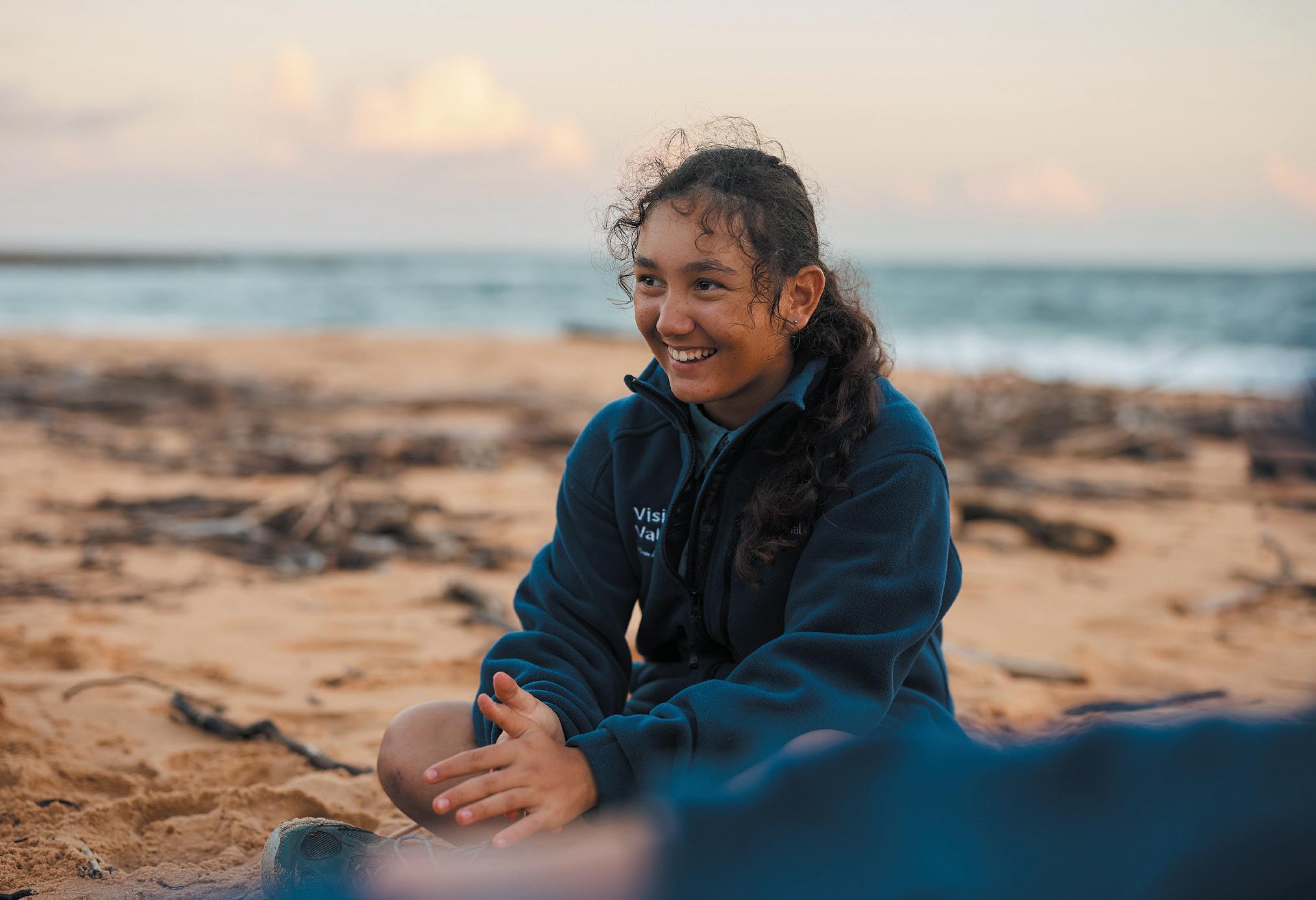
numinous
(adj.) describing an experience that makes you fearful yet fascinated, awed yet attracted – the powerful, personal feeling of being overwhelmed and inspired.
Many readers may have, at first, suspected a misspelling in the title of this article. And while there is harmony with the terms numinous and luminous, the bright spark that makes an experience numinous may not be perceived by the human eye alone.
My own memories that are ignited when reading this definition come from a sense of the sublime and the feeling of something bigger than self (Casement and Tacey, 2006). Gazing up at the night sky, watching the sun glide into the water over the equator, stepping gently through ancient ruins,
crawling into the crater of a volcano, gliding fingers over unnatural grooves ground into rock, looking into the eyes of my children for the first time.
While the above definition will have provoked a different memory for
“Gazing up at the night sky, watching the sun glide into the water over the equator, stepping gently through ancient ruins, crawling into the crater of a volcano, gliding fingers over unnatural grooves ground into rock, looking into the eyes of my children for the first time.”
each reader, we all share in the deep emotional response that is numinosity. In my recent travels to Japan to represent Pymble at the 10th International Outdoor Education Research Conference (IOERC10), numinous was a nominal term poised by Dr Judith Blaine (University of Hong Kong) to describe the connection to nature that is at the core of outdoor education.
Traditionally, this feeling would have been associated with spiritual or religious connotations (Nörenberg, 2017). There is an underlying epistemological assumption separating religious language and numinous experience, which extends beyond the parameters of our uniquely human experience (Schlamm, 1992). The concept of nature as a medium to the divine presents a mosaic of examples and experiences, which Spratt simplifies as “to find God in nature” (2012, p. 155).
Recent literature notices a distinct shift in the language used by emerging generations regarding how they express this sense of awe and connection (Wittberg, 2021). For Generation Z (1997 – 2010) and Generation Alpha (2010 – 2025), connection is often confused with connectivity (Jha, 2020), and the digital landscape around them more likely to be artificially luminous than numinous. Some individuals in these generations are unsure how to articulate anthropomorphic beliefs and bigger-than-self experiences (Wittberg, 2021), with emotions reversely personified as a technology itself that can be charged or drained. But is this a language disconnection or an experience disconnection?
With my own children and the majority of our Pymble student community being part of what is termed Generation Alpha, there is a need to understand how this generational shift may reflect the communication of this feeling, one bit at a time.
Following Dr Blaine’s use of the word ‘numinosity’ in an outdoor education context, the intellectual dialogue amongst world-leading researchers cracked open a gap in current literature relating to the instruments used to measure a connection to nature. How do we measure that which cannot be seen, heard or experienced? This articulative confusion presents the recognised need to research the benefits of outdoor education, as an area that is not widely celebrated as traditional higher-order learning.
My intention in this article is to introduce examples of emerging outdoor education research across the world, and identify where our
Vision Valley Year 9 Residential Program and K-12 OEP Continuum fits in this big and beautiful natural world.
The International Outdoor Education Conference (IOERC) series began in 2001 to address a gap in the scholarly outdoor field, with a perceived need to see the outdoors develop as a significant discipline that engages with social, educational and cultural frameworks within critical dimensions. Remarkably, Pymble was the only school in the world to be represented at the 10th IOERC in Japan, placing us at the forefront of outdoor education research globally.
As I arrived in Japan on the first morning of the conference and entered the IOERC10 Welcome Event, the passion for outdoor education was apparent. From across the world, professors, innovators and pioneers in outdoor education research came together for the week to spark dialogue into the future of outdoor education in an increasingly built world. Researchers arrived wearing suits with hiking boots, or blouses and broad-brimmed hats,

laptops and carefully preserved research posters stuffed inside hiking packs. Our real-life Indiana Jones hybrid of researcher and explorer.
At the conference, I presented with Professor Tonia Gray and PhD candidate Helen Cooper from Western Sydney University on the research conducted at the Year 9 Residential Program. Titled Assessing the Impact of the Vision Valley Outdoor Education Pilot Initiative at Pymble Ladies’ College (Cooper et al., 2023), the research collaboration with Western Sydney University focused on the 2022 pilot program, where students from two singlesex schools joined together for the pioneering co-educational four-week Year 9 Residential Program at Vision Valley. In this project, quantitative methodology used unique, rigorous instruments to research three factors; students’ sense of belonging using the Programme for International Student Assessment (PISA) scale (ACER, 2018); academic buoyancy using the Academic Buoyancy Scale (Martin and Marsh, 2008); and resilience using the Adolescent Girls’ Resilience Scale (AGRS) (Whittington and Aspelmeier, 2018). Immersive, qualitative methodology collected

The intentions of Pymble’s Residential Program are not for students to co-exist with static learning opportunities, but rather to become co-constructors of their learning and promote a deeper connection to self, others and the natural world. It was fitting that across the five-day conference and over a hundred and fifty presentations, the overarching theme of IOERC10 was connection. This included connection to nature through sustainability and beauty, connection to place by honouring First Nations voices and connection to the journey of our young people to find personal identity and belonging.
comfortable in nature. But can we map out the spectrum of comfort from those who gingerly ease themselves down to sit directly on grass, to others who use tiny bare hands to calmly grasp the leech crawling up their shoe? If we then look to relate connection with nature to numinous experience, comfort may lie a stone’s throw away or in the pot of gold at the end of the rainbow.
The need for connection to nature beyond the early years was highlighted by Mitchell and Sprague (Stramash Social Enterprise, UK) at IOERC10. Their presentation built on the WWF Natural Change
“As an evidence-informed school, the program continues to evolve, taking key findings and triangulated data from student, parent and staff experiences to allow the Vision Valley team to provide increasingly rich and rigorous learning opportunities.”
data at key points along the journey to learn from students, staff and parents over the four-week program. Findings from this research show increases across all three factors, with statistically significant increases in the AGRS subscale of Approach to Challenges (t(43) = -2.60, p. = 0.006).
Grounded research in connection begins in the early years setting with children in the pre-school years. This is where connection with nature is defined as comfort in nature (Lumber, Richardson and Sheffield, 2017). Anecdotally, it is simple to notice young children who are more
Project (Key and Kerr, 2017) and the Nature Relatedness (NR) scale constructed by Nisbet, Zelenski and Murphy (2009) to assess the cognitive and experiential aspects of individuals’ connection to nature for social change. This concept of going beyond knowing nature
to anthropomorphising nature for environmental action has been further explored by Lumber, Richardson and Sheffield (2017) for the creation of nine values of nature connectedness. Interestingly, the values align with a similar range of student personalities we often see at Vision Valley. Some students connect with nature by recognising its beauty (aesthetic), others want to know how, why and why not (scientific), or perhaps have a genuine fear of nature (negativistic). As educators, we must recognise which value each student prioritises to nurture their journey to forging self. In catalysing leadership, the ownership is transferred to our students who feel empowered and gain self-efficacy – the essence of what adolescents (and their parents) crave (Pritchard et al., 2020).
Another theme of connection probed by leaders in outdoor education research at IOERC10 was the enactment of place-
responsive outdoor education for connection. Place-based research has evolved from being in places to connecting with places, and with it the need to adapt place-responsive pedagogical frameworks to guide educators. Leong, Ho, and Seng Tay (Ministry of Education, Singapore) presented on a Singaporean case study implementing new curriculum framework for the interdependence of adventure, resilience and connection. The framework focuses on nurturing an ecological, social and physical sense of place to increase engagement and determine attitude to experiences (Adams et al., 2017). In our uniquely Australian setting, First Nations stories, histories and culture set the foundation for place-based connection.
The Year 9 Vision Valley Residential Program is a now a core component of students’ education at Pymble From our pioneering cohort in 2022, to the compulsory nature of the program in 2024, each shift, pivot
or jump in the program has been driven by research. As an evidenceinformed school, the program continues to evolve, taking key findings and triangulated data from student, parent and staff experiences to allow the Vision Valley team to provide increasingly rich and rigorous learning opportunities.
Fascinatingly, the one word that stood out to me at the conference cannot not be found anywhere on the IOERC10 program summary, abstract book, nor likely in the scribbled notes of most audience members. Perhaps we don’t need to research or measure numinosity to remember the numinous? What numinous memories do each one of us hold? To capture this essence, we need to free the beautiful dance of human nature and natural nature. We need to cleave self to forge anew, and we need to be vulnerably open to feel a sense of awe in the revolving and evolving world.
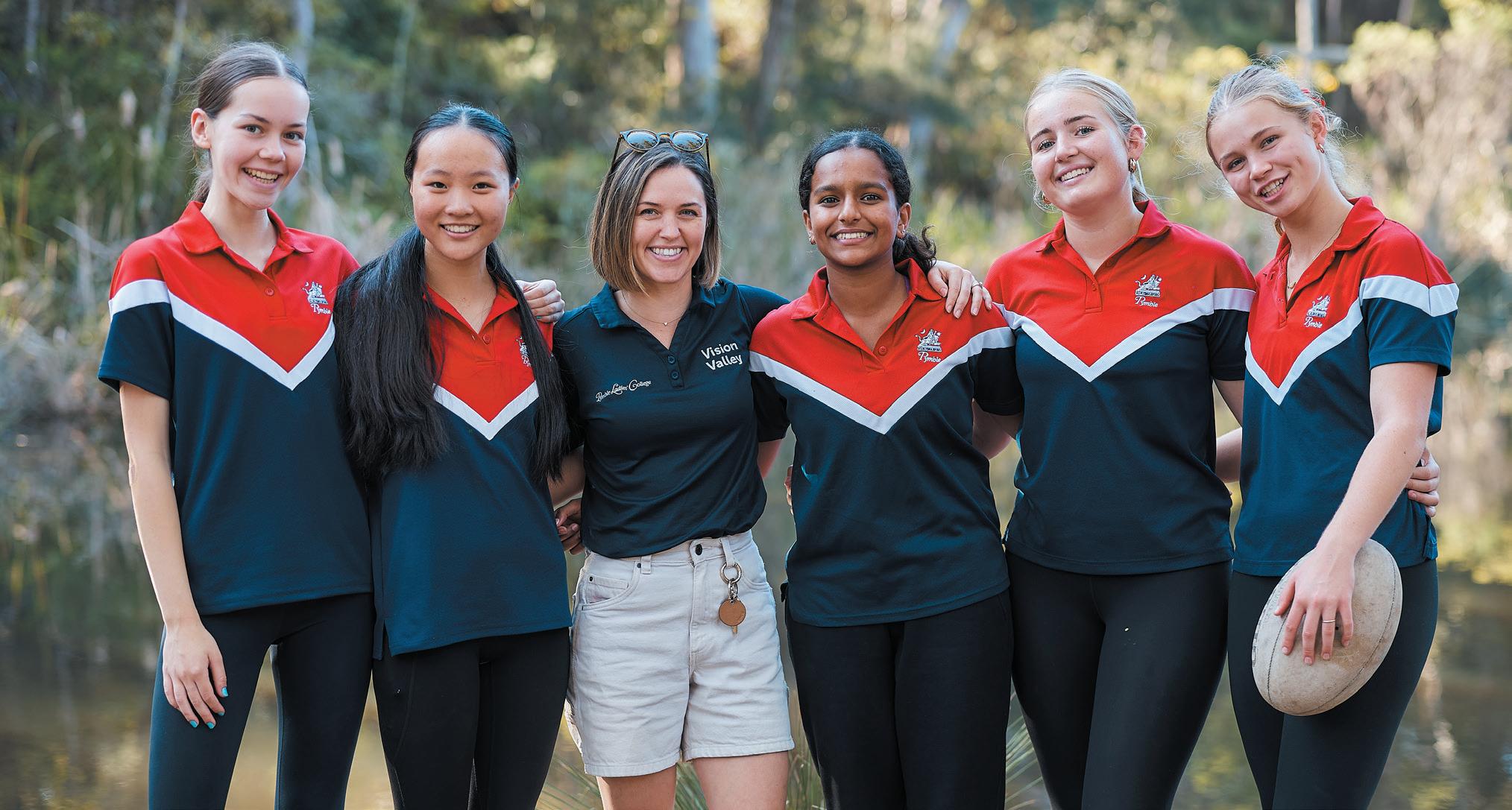
Adams, J., Greenwood, D., Thomashow, M. and Russ, A. (2017). Sense of place, in Urban Environmental Education Review Chapter 7, pp. 109-118. Cornell University Press. https://doi. org/10.1515/9781501712791-009.
Australian Council for Educational Research [ACER]. (2018). Programme for International Student Assessment (PISA) Australia in focus, Number 1: Sense of belonging in school. Available at: https:// research.acer.edu.au/ozpisa/30/
Casement, A. and Tacey, D. (2006). The idea of the numinous: Contemporary Jungian and psychoanalytic perspectives Routledge. https://www.routledge.com/The-Idea-of-the-NuminousContemporary-Jungian-and-Psychoanalytic-Perspectives/CasementTacey/p/book/9781583917848.
Cooper, H., Ullman, J., Curry, C. and Gray, T. (2023). Assessing the impact of the Vision Valley outdoor education pilot initiative at Pymble Ladies’ College. Research Report. Penrith, NSW: Western Sydney University. https://doi.org/10.26183/a33h-sr84.
Jha, A. K. (2020). Understanding Generation Alpha. OSF Preprints. doi: 10.31219/osf.io/d2e8g.
Key, D. and Kerr, M. (2011). WWF Scotland. The Natural Change Project: Catalysing leadership for sustainability. Available at: https:// assets.wwf.org.uk/downloads/wwf_naturalchange2.pdf
Lumber, R., Richardson, M. and Sheffield, D. (2017). Beyond knowing nature: Contact, emotion, compassion, meaning and beauty are pathways to nature connection, PLoS ONE, 12 (5), p. e0177186. https://doi.org/10.1371/journal.pone.0177186.
Martin, A. J. and Marsh, H. W. (2008). Academic buoyancy: Towards an understanding of students’ everyday academic resilience, Journal
of School Psychology, 46(1), pp. 53-83. https://doi.org/10.1016/j. jsp.2007.01.002.
Nisbet, E. K., Zelenski, J. M. and Murphy, S. A. (2009). The Nature Relatedness scale: Linking individuals’ connection with nature to environmental concern and behaviour, Environmental and Behavior, 41 (5), pp. 715-740. https://doi.org/10.1177/0013916508318748.
Nörenberg, H. (2017). The numinous, the ethical, and the body. Rudolf Otto’s “The Idea of the Holy” Revisited’, Open Theology, 3, pp. 546564. https://doi.org/10.1515/opth-2017-0042.
Pritchard, A., Richardson, M., Sheffield, D. and McEwan, K. (2020). The relationship between nature connectedness and eudaimonic well-being: A meta-analysis’, Journal of Happiness Studies, 21, pp. 1145-1167. https://doi.org/10.1007/s10902-019-00118-6.
Schlamm, L. (1992). Numinous experience and religious language, Religious Studies, 28, pp. 533-551. Cambridge University Press. https:// doi.org/10.1017/S0034412500076531.
Spratt, S. (2015). “To find God in nature”: Thoreau’s Poetics of Natural History, Mosaic: An Interdisciplinary Critical Journal, 45 (1), pp. 155169. Available at: https://www.jstor.org/stable/44029790
Whittington, A. and Aspelmeier, J. (2018). Resilience, peer relationships, and confidence: Do girls’ programs promote positive change?, Journal of Outdoor Recreation, Education, and Leadership, 10 (2), pp. 124-138.
Wittberg, P. (2021). Generational change in religion and religious practice: A review essay, Review of Religious Research, 63, pp. 461482. https://doi.org/10.1007/s13644-021-00455-0.
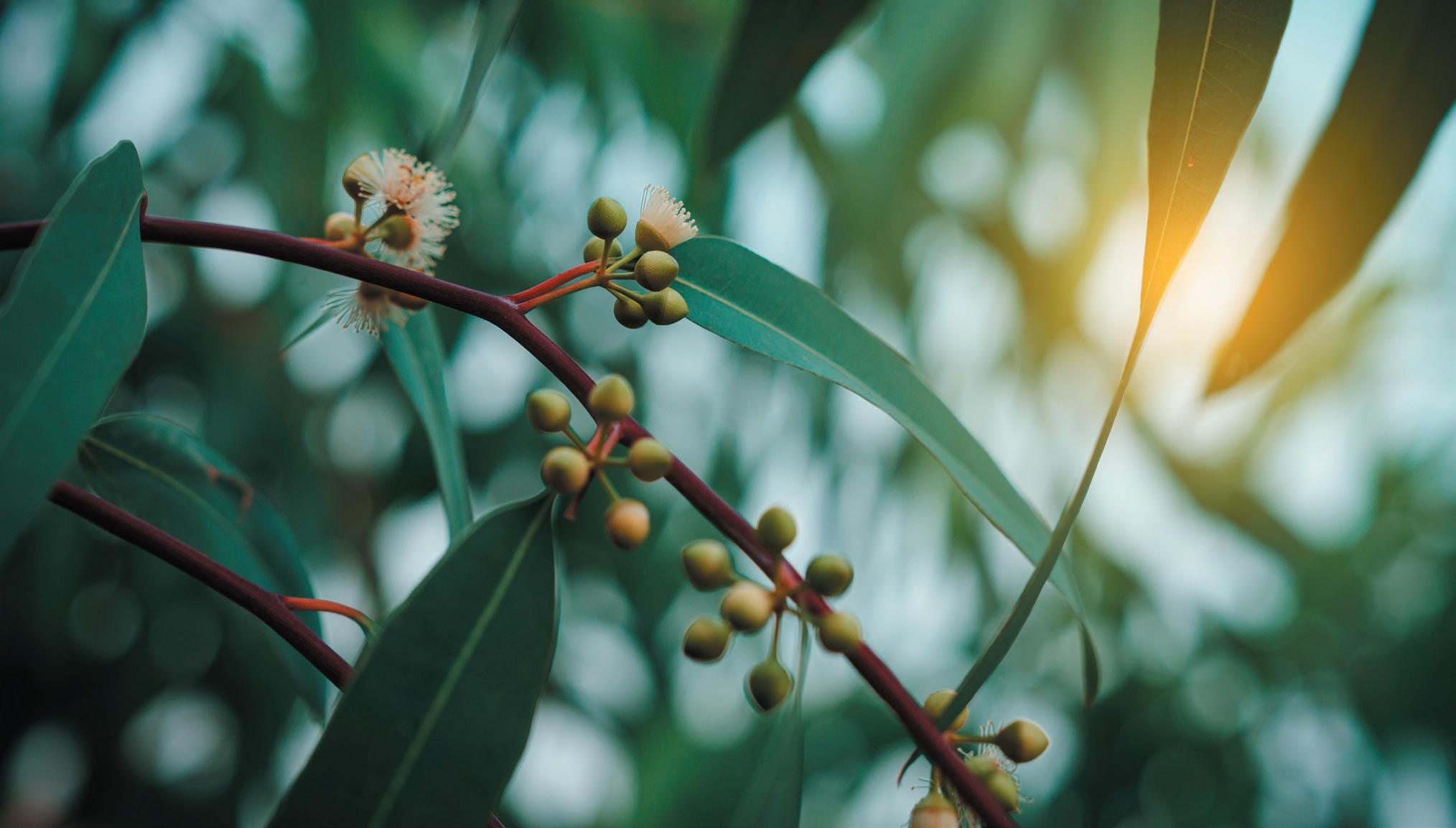
Tom Riley, Head of Campus - Vision Valley, Pymble Ladies’ College
I was very fortunate to be part of the AISNSW’s Flagship Senior Executive Leadership Program in 2023. The program, now in its tenth year, affords aspiring staff the opportunity to work with like-minded individuals considering principalship in their future. Connecting with your cohort of ‘flagshippers’, you spend the year navigating ten days of face-to-face learning, regularly meeting with your ex-principal mentor, shadowing a current principal, and exploring
current and seminal leadership research. The project culminates in the presentation of your ‘Future Focused Strategic Initiative’ (FFSI) to your principal, those of your peers, and your in-school mentors (whom for me was Ms Lamia Rockwell –Deputy Principal).
When discussing mastering leadership, Anderson and Adams (2016) identify that the spirit of leadership is found in a leader’s ability to connect with something greater
than themselves and inspire others to do the same, ultimately creating a sense of meaning and purpose for the organisation. Our own ’Flagship’ experience was characterised by a distinct inner and outward journey, and in reflecting on my own life events that had led me to being on the course, I began to see the connections to the external work required of me and our team. This introspection led me to return to the initial purpose of the Residential Program, inspiring a greater sense
of self in our girls, and consequently, I found myself drawing parallels within the research I was involved in through the Pymble Institute, my Future Focused Strategic Initiative, and that of Vision Valley as a whole. This web of research interconnectivity helped to broaden the reflective conversations within each, and distilled our sense of purpose in making evidenceinformed decisions to lead our exciting and evolving program forward.
I entered Flagship excited, yet not without some initial reservations. Having seen many colleagues across the state graduate, I worried that it may be a formulaic leadership development program, and not the bespoke individual journey for which I was hoping. Pleasingly, it proved to be deeply personal and enlightening, emphasising that leadership is not one-size-fits-all. This relates strongly to research indicating that leadership development programs that prioritise individualised approaches and emotional intelligence significantly enhance leaders’ effectiveness and personal growth (Leroy et al., 2020). The diversity within the group, including leaders from various fields, provided a unique perspective and fostered meaningful discussions. It reaffirmed that leadership is a continuous journey of self-discovery and growth, with an emphasis on authenticity and adaptability. It also fostered a stronger sense of self and comfort in your own skin. Indeed, it was this realisation that prompted me to draw parallels to the growth and reflection we ask of our Year 9 students during their Residential Program at Vision Valley, and why it is important as both an adult and a
leader to model the discomfort, that is not without reward, of growth through personal challenge. Michelle Obama, in her own account of “becoming”, famously said, “There are simply other ways of being” (Obama, 2018) and it is this wise realisation that is not, or perhaps should not, be unique to children.
The Year 9 Residential Program has been designed around three key pillars: fostering a stronger sense of self, making stronger connections with others, and becoming better connected with the natural world. Collectively, these help to build a picture of authenticity. Recent findings highlight the critical role of authenticity in leadership, underscoring that leaders who engage in self-reflection and authentic behaviour foster greater trust and performance within their teams (Van Dierendonck, 2021).
To ascertain the students’ own perceptions of their ability to grow their authenticity, beyond the longitudinal research Vision Valley has undertaken in conjunction with Western Sydney University and the Pymble Institute, I chose to design and evaluate a program-wide reflection schedule embedded into their four-week stay. The students were surveyed at the beginning, middle, and end of their stay at the Valley, each answering three sets of five questions that probed their perceptions of:
• Self: understanding self means having insight into one’s own behaviours, beliefs, attitudes, strengths, weaknesses, and values.
• Others: connecting with others requires you to be your authentic
self in building meaningful relationships in which both parties feel they can belong and be themselves.
• The Natural World: spending time in nature can slow the mind, reduce stress, provide important perspectives, and allow you to be more present in your daily lives.
Excitingly, the results were very positive with just over 72 per cent of respondents indicating a positive improvement in their perceived connection to self, others, and the natural world during their stay. To conclude my Flagship journey and to consolidate my FFSI, I combined my personal and research journey into one poster, to be presented at a mini-conference at the Association of Independent Schools (NSW).
72%
of students showed improved connection to self, others and the natural world
• Improved feeling of belonging, connection to and enjoyment of time with others
• Improved feeling of authenticity
• Improved connection to self across all domains
• Improved ability to manage stress and appreciation for what they have in the world
• Very little change to gratitude (noting this began at 3.72/4) and knowledge of First Nations perspective
As you can see in Figure 1, I chose to illustrate authenticity akin to the famous Iceberg Leadership Model analogy. Authenticity is what will show up in your daily interactions with peers, friends, family, and colleagues. It is founded upon an aptitude to know and to care for self through critical reflection, enhanced connection with others, and the ability to detach and zoom out in seeing the bigger picture. Authentic leadership, characterised by strong self-awareness and relational transparency, significantly improves team cohesion and performance (Neider & Schriesheim, 2022). Helping students to better see the foundations upon which their core beliefs are established, and which they can grow both individually and collectively, is the raison d’être of the Residential Program. Whilst not yet necessarily leading others in a formal sense, this improved ability to appreciate and to foster authentic peer relationships helps to improve emotional regulation in adolescence through enhanced wellbeing and social competence (Allen, Narr, Kansky & Szwedo, 2018).
As highlighted by Garvin, Edmondson, and Gino (2008), research-based thinking is essential for leaders because it underpins informed decision-making, enhances credibility, fosters adaptability and innovation, improves problem-solving skills, boosts organisational performance, and promotes a culture of continuous learning. By integrating the best available evidence into their leadership practices, leaders (and, therefore, schools) can navigate complex challenges more effectively and drive their organisations toward sustained success.
“In discussing the impact of the Residential Program at Pymble, we will often informally reference that much of our work is found in planting the seeds for trees whose shade we will never see.”
So often as an educational leader, we are required to make a decision, the ripples of which we cannot predict, nor prevent, once set in motion. Rousseau (2006) positions that evidence-based management enhances the quality of decisionmaking processes by systematically applying the best available evidence. In discussing the impact of the Residential Program at Pymble, we will often informally reference that much of our work is found in planting the seeds for trees whose shade we will never see. Indeed, teaching as a profession is largely an interconnected series of decisions and evidence guided movements, with no clear, nor linear, path, and no certainty of the destination. Thus, with educators required to make decisions of this gravity and magnitude, the situation demands robust and informed thinking to guide evidence-based choices. The rise of research institutes within many of Australia’s pioneering private schools, themselves members of Research Invested Schools Network, points to cultures of research helping to develop ever deeper understanding and expand the need to promote a learning culture across all areas of the school.
Internal research within schools, conducted by developing leaders, when regularly shared, also helps both the school and wider profession keep abreast of developing trends. O’Reilly, Caldwell, Chatman and Doerr (2014) posit that this ultimately makes those institutions more agile
in adapting to change through innovation, and whilst there exists the danger of chasing the latest educational fad, COVID-19 and the recent emergence of AI highlight the need for schools and teachers to be able to pivot at a moment’s notice in our unpredictable world. Encouraging internal research to be shared with a broad audience also demonstrates a commitment by the school to develop credibility and trust, and to have their thinking challenged through critical debate.
I have certainly enjoyed not being assured of what I will discover through my own research and sharing the journey with my colleagues at both the Vision Valley and Pymble campuses. Whilst anecdotally certain of the transformative impact of the Residential Program, having witnessed over three hundred graduates of the program to date, I feel encouraged from our varied research journey that the positive developments from their four-week stay will permeate their wider lives long after they have departed. Indeed, the positive effect observed across each of the different instruments and studies, initially carried out in isolation to each other, is a testament to the broader impact. I, too, feel very fortunate to have been afforded a similarly introspective learning opportunity through the Flagship Leadership Program and I share the thirst for authenticity with our Year 9 Residential Program Adventurers as I look to the future.




Head of Upper School





During

I
I






















































































































































As the son of two teachers, schools have always been in my blood. Having moved to Australia alone at 19, I embarked on my teaching career. Working across all boys, all girls, and co-educational schools, I have been fortunate to experience a variety of roles in academia, pastoral care, and innovative projects related to experiential learning. I care deeply for students connecting to context and finding engagement in their education as purposeful learners. I am in my third executive role across two schools and have ambitions to become a principal, but I also recognise the need to take time to enjoy the journey and focus on my family.
















































The


































Allen, J. P., Narr, R. K., Kansky, J., & Szwedo, D. E. (2018). Adolescent peer relationships and the development of emotional regulation. Journal of Research on Adolescence, 28(2), 362-377
Anderson, R., & Adams, W. A. (2016). Mastering Leadership: An integrated framework for breakthrough performance and extraordinary business results. Wiley.
Garvin, D. A., Edmondson, A. C., & Gino, F. (2008). Is yours a learning organization? Harvard Business Review, 86(3), 109-116
Leroy, H., Anseel, F., Gardner, W. L., & Sels, L. (2020). Authentic leadership, authentic followership, basic need satisfaction, and work role performance: A cross-level study. Journal of Management, 46(4), 672-698.
Neider, L. L., & Schriesheim, C. A. (2022). The authentic leadership
inventory (ALI): Development and empirical tests. Leadership Quarterly, 33(1), 101-110.
O’Reilly, C. A., Caldwell, D. F., Chatman, J. A., & Doerr, B. (2014). The promise and perils of organizational culture: An academic reflection. The Academy of Management Perspectives, 28(4), 509-515.
Obama, M. (2018). Becoming. Crown.
Rousseau, D. M. (2006). Is there such a thing as “evidence-based management”? Academy of Management Review, 31(2), 256-269
Van Dierendonck, D. (2021). Servant leadership: A review and synthesis. Journal of Management, 47(6), 1487-1525.
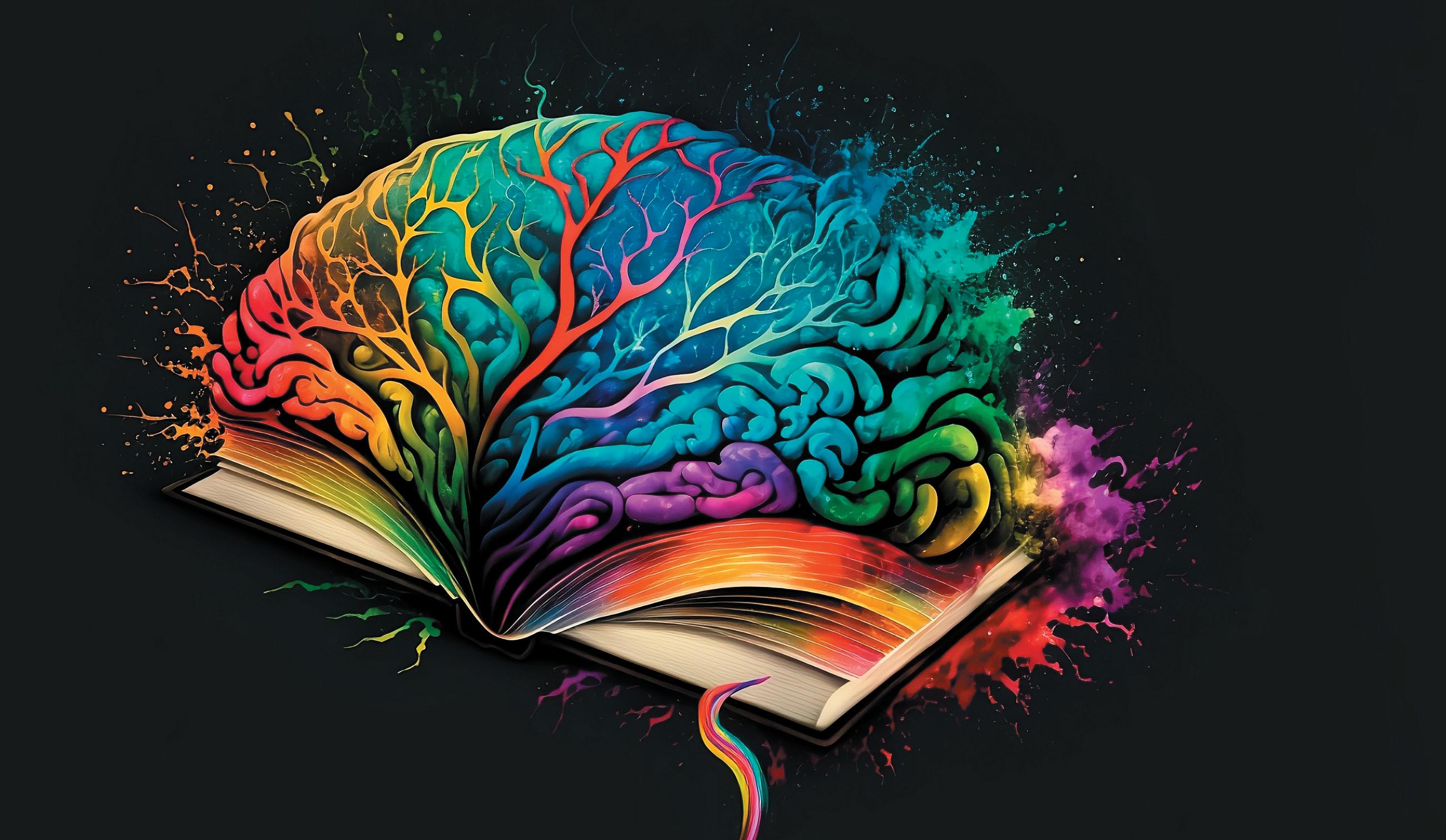
Melinda Pedavoli, Head of Drama and Theatre Production, Pymble Ladies’ College
In today’s fast-paced world, students are more adept than ever at multitasking. They effortlessly manage various activities—chatting with friends on video calls, streaming music, and tackling their studies—all at the same time. And their ability to navigate often complex social and digital landscapes continues to accelerate. But how are we, as educators, adapting our approaches to meet the demands of this rapidly evolving environment?
Whilst there is conjecture about whether this constant stimulation from digital devices is shortening students’ attention spans, others argue that students are developing new forms of literacy and cognitive skills adapted to the digital age, such as faster information processing and the ability to synthesise information from diverse sources.
In either case, our learners have changed, and so has their learning process.
To better support and engage both current and future learners, our learning environments need to reflect the interconnected, rapidly evolving world students navigate daily, integrating technology in ways that drive change and challenge existing practice. In the context of high school education, the urgency for digital transformation has been at the forefront of strategic vision planning for some time and has increased exponentially since the pandemic (Ng et al., 2021). Bertrand
and Namkasa (2020) point to three key areas of growth brought about by the opportunity to experiment and play with technology - these include perseverance, collaboration and critical thinking. Whether through interactive digital platforms, collaborative online projects, or realtime feedback systems, our teaching practices need to evolve to harness the potential of our cross-tasking students. By doing so, we not only keep pace with our students but also empower them to become active participants in their learning journey, developing the critical thinking and problem-solving skills essential for what the World Economic Forum is referring to as the fourth industrial revolution.
Of course, if we are to integrate creative processes into our interactions with technology, and vice versa, we must be careful not to lose sight of the organic, fluid and unpredictable nature of creativity itself (Diluzio and Congdon, 2015). This is something I am often guilty of in my own practice, trying to pin down a recipe for creativity that has worked on one occasion, or forcing technology onto a creative exercise and stifling the process. With this in mind, it is important that initiatives designed to combine arts and technology acknowledge the distinct qualities of the disciplines and allow each to be leveraged meaningfully.
Interdisciplinary approaches such as STEAM, project-based learning and hybrid-pedagogy (which blends virtual learning with face-to-face teaching), offer rich and complex opportunities for students to engage with diverse concepts. These methods encourage collaboration, critical thinking, and creativity, enabling learners to see connections
across disciplines and apply knowledge in real-world contexts. By breaking down traditional subject boundaries, students develop a more holistic understanding of the material, equipping them with transferable skills that are essential for navigating an increasingly interconnected and dynamic world.
The need to prioritise an interdisciplinary approach to teaching is not new to educational discourse.
• In his 2015 Forbes article, George Anders asserted that arts and technology were driving industry productivity, whilst candidly acknowledging that the rapid evolution of technology meant that tech skills quickly became redundant and obsolete while arts skills continued to grow and transfer for life.
• In 2017, the National Education Standards Authority (NESA) developed additional crosscurricular STEM units to support integrated learning in Stage 6
• In South Australia, citizenship has been emphasised as a central capability within the South Australian Certificate of Education (SACE).
• And, more recently, the 2023/24 NESA curriculum reform has incorporated respect and responsibility as key priority values, acknowledging the skills deficits and ethical considerations of the future workforce.
Not dissimilarly, academic research argues for an interdependency between subjects, and reconceptualisation of teaching and learning, with some calling for more drastic action than others. In 1916,
Dewey argued that education should be a process of living and not just a preparation for future living. He advocated for an interdisciplinary approach where subjects were not isolated but integrated to help students understand the complexities of life. Almost one hundred years later, Hattie and Yates (2013) delve into the cognitive science behind learning, and the importance of making learning ‘visible’ to allow students to make connections between ideas and apply their learning in new ways.
Snow et al., (2016) argue for a cultural refocus, expanding our worldview to other practices, cultures and views of the world if we are to see teaching and learning as the synchronous ideas they are in Eastern and Indigenous cultures. Others argue a need to embed the arts into our science and technology programs to make knowledge transferable and cultivate the adaptability, social responsibility and aptitude for problem-solving imperative for students entering the twenty-first century job market (Watson, 2020). The increasing trend towards STEAM (Science, Technology, Engineering, Arts and Mathematics) initiatives – adding the A to the conventional STEM acronym - acknowledges the value of integrating creative thinking with scientific inquiry, fostering a more holistic approach to education and equipping students with versatile skills for the future.
Together, much of the academic research, grey literature and educational policy documents recognise the need for an interdisciplinary approach which activates the potential of holistic learning experiences and prepares
students for complex real-world challenges. In his 2024 discussion on competencies for the age of AI, Charles Fadel (2024) emphasises that fostering creativity and interdisciplinary pedagogy is crucial for equipping students with the problem-solving and critical thinking skills necessary to thrive in a rapidly evolving technological landscape. He argues that integrating these skills through interdisciplinary approaches not only enhances students’ ability to tackle complex problems but also prepares them to innovate and adapt in an increasingly complex world. Breaking down the entrenched hierarchy of knowledge shaped by high-stakes testing and shifting focus to the value of shared understanding, creativity, and reciprocity is no easy task. However, this transition is crucial if we are to evolve as educators, and design learning that prepares our students for their postschool experiences.
So, where do we start?
How do we encourage educators to take up an interdisciplinary approach to teaching?
And what does it look like, sound like and feel like to be intimately connected to classroom practice?
At the very least, we must start with an open imagination.
Embracing a more creative approach to education begins with open imaginations and a willingness to rethink traditional structures. Despite its conceptual simplicity, the execution of this approach may prove to be considerably more challenging. Unlike fields such as business or technology,
where innovation and agility are often celebrated and rewarded, the conservatism of educational institutions, compounded by standardised testing, contributes to a more cautious, risk averse culture.
However, there are inspiring examples of schools that have successfully navigated this inertia. The Vittra schools in Sweden are renowned for their innovative education, with Project-Based Learning (PBL) at the core of the curriculum at Vittra Södermalm in Stockholm. Here, students explore ‘Sustainable Development’ by examining the school’s carbon footprint, analysing energy use in science, calculating savings in mathematics, and crafting persuasive strategies in language arts. Collaboration with local environmental organisations provides hands-on experience, enabling students to make a real impact on their community.
In Finland, known for its emphasis on student autonomy and inquiry-based learning, PBL is widely integrated into schools. At Helsingin Suomalainen Yhteiskoulu (SYK) in Helsinki, students design ‘sustainable cities’ by working in interdisciplinary teams, drawing on geography, environmental science, economics, and civic studies. This project concludes with students pitching their ideas to local urban planners, linking learning directly to real-world issues.
The power of PBL in fostering interdisciplinary learning is not confined to Europe. Located in San Diego, California, High Tech High is often cited as a pioneering example of PBL in action, with students engaging in long-term projects that require them to apply knowledge
from multiple disciplines. One notable example is their ‘Into the Wild’ project - an interdisciplinary study of local ecosystems. The project integrates biology, environmental science, and outdoor education as students research native species, design conservation strategies, and create interactive maps of local wildlife habitats. Emphasising real-world relevance, critical thinking, and collaboration, students present their findings and conservation plans to the community, enhancing both their environmental awareness and presentation skills. And, while we’re discussing interconnected learning, their website is a noteworthy example of collaborative sharing, offering access to more than 100 PBL projects (see https://www.hightechhigh.org/ student-work/projects/2/). If you’ve read this far, you should certainly check it out!
SYNERGY: LEVERAGING THE CREATIVE ARTS BEYOND PROJECT-BASED LEARNING
In our increasingly digitised world, where students must navigate complex, ambiguous information and innovate in rapidly changing environments, Creative Arts pedagogy has proven to enhance emotional intelligence and foster a growth mindset. However, its value extends beyond these benefits. By virtue of its collaborative, projectbased approach, Creative Arts pedagogy invites problem-solving and cultivates an agentic approach to learning in a physical space which affords experimentation and discovery.
Adapting PBL principles in my own teaching, I’ve experienced firsthand how creating hands-on learning environments leads to
more meaningful problem-solving among students. However, it is not everyone’s preferred approach. So, what specific elements of PBL can we borrow from to refine our pedagogy and inspire the real-world application that PBL so successfully facilitates?
My diverse experience as a Leader of English, Head of Teacher Development, and Drama and Theatre practitioner has provided me with insights into how various learning environments impact the engagement and interaction of both students and staff. When observed side by side, these environments highlight the power of space in leveraging effective learning. In particular, the Drama space stands out for cultivating a dynamic and engaging learning environment that addresses the limitations often found in more homogeneous classroom settings.
Owing to its inherent flexibility and creative collaboration, the Drama space supports a truly interdisciplinary approach, which promotes collaboration, risktaking and imagination (Nicholls & Phillip, 2012). This unique setting encourages students to step out of their comfort zones, engage creatively with peers, and explore complex ideas through experimentation, making it an ideal space for fostering critical skills that extend beyond the classroom. Teaching and learning in this space adhere to the design principles of the makerspace, providing access to digital resources that are designed to promote problem solving, and encourage students to find innovative solutions to complex problems (Shivley, Stitch & Rubenstein, 2021). Thus, the work produced is both intimately connected to the students’ own
beliefs, values and identities, and completes the makerspace trifecta - offering a “space, resources, and opportunities” for teams of learners to create a product unique to them (Shivley, Stitch & Rubenstein, 2021).
This space looks dynamic and responsive - students’ impulses and experiences shaping the direction of learning. It sounds lively, exclamatory, and spontaneous – uninhibited dialogue and wandering tangents interspersed with concentrated silences. And particularly in the girls’ school context, it feels empowered, with genuinely co-constructed ideas, ‘penny drop’ insights and the infectious spirit of teenage girls buzzing with creativity. Perhaps due to its willingness to relinquish control and embrace experimentation — even with the risk of making mistakes — effective Drama pedagogy helps students engage with their learning in a way that sparks intrinsic motivation and creativity. Likewise, the Drama space can allow for a refocus that facilitates informal, collective learning to blend fluidly with dreams and visions, ceremonies and rituals; even problem solving is communal (Merriam & Baumgartner, 2020).
On one occasion, fifteen Drama students strung 900 fairy lights from the theatre balconies to tell the Wiradjuri Dreamtime story of the emu spirit. On another occasion, twelve students worked together on a multimedia installation depicting the legacy of renowned Indian mathematician, Srinivasa Ramanujan. By integrating live performance with music, voiceover, and archival footage, students theatricalised the functional equations of the Riemann zeta function. And to clarify, without resorting to clichés, these were not mathematically inclined students. Like PBL, the iterative process
of theatre-making, including opportunities for authentic feedback from peers, safeguards high levels of student interest (Heredia & Tan, 2021). By rethinking curriculum and classroom design, to prioritise collaboration, critical thinking and creativity, teachers and institutions can move beyond traditional cycles and embrace a more socialised and integrated approach to learning. This shift requires a collective commitment to innovation and a willingness to explore the unknown, but the rewards are a more dynamic, relevant, and engaging educational experience for all.
Having undertaken a close investigation of the research supporting effective teaching and learning strategies, our College literature review augments the need to foster growth-mindsets (Dweck, 2006), epistemic agency (Lai & Campbell, 2018), and self-directional skills in our students (Sze-yenga & Hussain, 2010).
As educators, we’ve seen firsthand the transformative power of fostering a growth mindset in our classrooms. Drawing either consciously or subconsciously from Carol Dweck’s (2006) research, we embrace the idea that abilities and intelligence are not fixed, and consistently advocate that effort and perseverance are the game-changers for success.
In an inspiring move towards enhancing educational practices at the College, 145 Pymble staff members engaged with the Royal Society of the Arts capabilities framework (2023) through professional dialogue and a comprehensive survey. This
collaborative effort is one of the formative stages in the development of a robust framework for the future of teaching and learning at the College. The survey’s findings indicate the majority of staff saw critical thinking and resilience as the top priorities, reflecting a unified emphasis on these skills in shaping the educational framework. By aligning the framework with Robinson’s (2015) emphasis on creativity, critical thinking, and personalised learning, our learning team is set to transform pedagogical approaches and drive meaningful changes in classroom experiences. This initiative not only underscores the value of teacher collaboration but also highlights a forward-thinking approach to integrating essential skills into everyday teaching practices. And, not to mention, a socialised approach to fostering a shared understanding and application of these skills across our educational community.
The perspectives shared by staff were well in line with the evidence presented in the College literature review, where a range of studies linked critical thinking with academic success and student motivation (Sahidun, 2023; Susanti et al., 2020; Puzziferro, 2008; Wang & Wu, 2008; Elliot et al., 1999; Dembo, 1994; Dembo et al., 2006). More specifically, Sze-yenga and Hussain (2010) highlight that students with strong self-directed learning skills are more motivated by personal growth and mastery, leading to greater academic success. They emphasise the importance of fostering these skills in education, as it promotes autonomy, confidence, and lifelong learning adaptability.
To succeed in the workplace of
the future, it is these adaptive and transferable skills, including the resilience needed to take risks, and the agile mindsets needed to think critically and collaborate across diverse platforms and cultures, that our students will rely on. Harnessing the potential of socialised spaces and fostering a culture of collaborative learning can help dismantle siloed thinking and redefine classrooms as vibrant centres of learning where challenges are seen as opportunities for growth.
“It has been proven time and time again in countless studies that students who actively participate in arts education are twice as likely to read for pleasure, have strengthened problem-solving and critical thinking skills, are four times more likely to be recognised for academic achievement, four times more likely to participate in a math and science fair….” — Quincy Jones
By moving beyond rigid subject boundaries, we can create learning environments that reflect the complexities of real-world problemsolving in a way that empowers students to think critically and creatively across domains. Nurturing the diversity of approaches required for authentic socialised learning will take time but, in the interim, we can start by de-formalising the way knowledge is shared among teachers and students. Rather than trying to arrive at definitive answers, the research encourages us to recognise that physical spaces must work together with the human activities engendered by our learning spaces. Still, this shouldn’t stop us from accessing the potential of interconnected learning and spaces, or asking:
What’s possible when space and pedagogy align?
How can educators leverage the collaborative multitasking of our students?
And, why can’t subjects be friends too?
Anders, G. (2015). That “useless” liberal arts degree has become tech’s hottest ticket. Forbes. https://www.forbes.com/sites/ georgeanders/2015/07/29/liberal-arts-degree-tech/?sh=fac5c6b745d2
Bertrand, M.G., & Namukasa, I. K. (2020). STEAM education: Student learning and transferable skills. Journal of Research in Innovative Teaching & Learning, 13(1), 43–56. https://doi.org/10.1108/JRIT-012020-0003
Getting Smart Podcast (2024). Charles Fadel on Education and Competencies for the Age of AI, Getting Smart, January 31 2024; https://www.gettingsmart.com/podcast/charles-fadel-on-educationand-competencies-for-the-age-of-ai/
Hattie, J., & Yates, G. C. R. (2013). Visible learning and the science of how we learn. New York: Routledge.
Heredia, S.C., & Tan, E. (2021). Teaching & learning in makerspaces: Equipping teachers to become justice-oriented maker-educators, The Journal of Educational Research, 114:2, 171-182. DOI: 10.1080/00220671.2020.1860871
Dembo, M. (1994). Applying education psychology (5th ed.). White Plains, New York: Longman
Dembo, M. H., Junge, L. G., & Lynch, R. (2006). Becoming a selfregulated learner: Implications for Web-based education. Web-based learning: Theory, research, and practice. Mahwah, NJ: Lawrence Erlbaum Associates.
Diluzio, R., & Congdon, C. B. (2015). Infusing the creative-thinking process into undergraduate STEM education: An overview. 2015 IEEE Integrated STEM Education Conference, 52–57. https://doi. org/10.1109/ISECon.2015.7119945
Dweck, C. S. (2006). Mindset: The new psychology of success. New York: Random House.
Elliot, A. J., McGregor, H. A., & Gable, S. L. (1999). Achievement goals, study strategies, and exam performance: A mediational analysis. Journal of Educational Psychology, 91, 549–563
Lai, K-W., & Campbell, M. (2018). Developing secondary students’ epistemic agency in a knowledge-building community, Technology, Pedagogy and Education, 27(1), 69-83, doi: 10.1080/1475939X.2017.1369150
New South Wales Education Standards Authority (NESA). (2017). Annual Report 2016-17. Parliament of NSW. https://www.parliament. nsw.gov.au/tp/files/72308/NESA%20Annual%20Report%202016-17.pdf
New South Wales Education Standards Authority (NESA). (2023). The NSW curriculum reform: A guide to the new priorities. https://www. nesa.nsw.edu.au/curriculum-reform
Nicholls, J., & Phillip, P. (2012). Solo life to Second Life: The design of physical and virtual learning spaces inspired by the drama classroom,
Research in Drama Education; The Journal of Applied Theatre and Performance, 17: 4, 583-602.
Merriam, S. B., & Baumgartner, L. M. (2020). Learning in adulthood: A comprehensive guide. John Wiley & Sons.
Ng, O., Liu, M., & Cui, Z. (2021). Students’ in-moment challenges and developing maker perspectives during problem-based digital making, Journal of Research on Technology in Education, doi: 10.1080/15391523.2021.1967817
Puzziferro, M. (2008). Online technologies self-efficacy and selfregulated learning as predictors of final grade and satisfaction in college-level online courses. American Journal of Distance Education 22(2), 72–89.
Quincy, J. (2009). Arts Education in America - https://www.huffpost. com/entry/arts-education-in-america_b_201127
Robinson, K. (2015). Creative schools: The grassroots revolution that’s transforming education. Viking.
Royal Society of the Arts. (2023). Capabilities for life framework https://www.thersa.org/design-for-life-our-mission/capabilities-for-life/ capabilities-for-life-framework
Shively, K., Stith, K., & Rubenstein, L. D. (2021). Ideation to implementation: A 4-year exploration of innovating education through maker pedagogy, The Journal of Educational Research, 114(2), 155170. DOI: 10.1080/00220671.2021.1872472
Sahidun, M., Suyitno, A., & Pujiastuti, E. (2023). Mathematical critical thinking ability through brain based learning model in view of selfregulated learning. International Journal of Trends in Mathematics Education Research, 6(2), 177–185.
Snow, K.C., Hays, D. G., Caliwagan, G., Ford, D. J., Mariotti, D., Mwendwa, J. M., & Scott, W. E. (2016). Guiding principles for indigenous research practices. Action Research, 14(4), 357–375. https://doi.org/10.1177/1476750315622542
Susanti, V. D., Krisdiana, I., & Adamura, F. (2020). Students’ mathematical critical thinking reviewed from self-regulated learning. Journal of Physics: Conference Series, 1613(1), 12008.
Sze-yenga, F., & Hussain, R.M.R. (2010). Self-directed learning in a socioconstructivist learning environment. Procedia Social and Behavioral Sciences, 9 ,1913–1917.
Watson, E. (2020). STEM or STEAM? The critical role of arts in technology education (and the critical role of art in technology). Irish Journal of Academic Practice, 8(1). doi:https://doi.org/10.21427/eqzbvb42. https://arrow.tudublin.ie/ijap/vol8/iss1/8
Wang, S.L., & Wu, P.Y. (2008). The role of feedback and self-efficacy on web-based learning: The social cognitive perspective. Computers & Education, 51(4), 1589–1598.
Dr Joshua McDermott, History Teacher, Pymble Ladies’ College
Dr Sarah Loch, Director – Pymble Institute
This article discusses the unassuming power of the literature review through the example of a review into literature on service in schools. One of the strategic goals of Pymble Ladies’ College this year is to develop a service framework and, to kick-start the project, a review of existing literature was conducted. The value of this approach is found in the depth of understanding of the issues involved and the opportunity to involve students, parents and staff in the journey to strategic change.
The first part of this article reflects on ways the academic process of finding, reviewing and analysing literature can be used in school decision making to support change strategies. The second part presents the literature review we wrote on the topic of service, as an example of this approach in action.
The College’s Social Intelligence strategic pillar is focusing on building a service framework to guide our approach to and decision making around charity, community service and service learning. The first phase of the project has entailed researching the field via a literature review, allowing an investigation into key concepts to take place.
A literature review is a useful addition to strategy work in a school as it allows the team working on the project to establish common ground and shared understanding about the terms, definitions, ideas and people being referenced. We believe it is important to emphasise that while a literature review is not prescriptive, it gives those working in schools, especially teachers and educational leaders, a clearer sense of the current scholarship, allowing for more informed decision making. This approach puts people ‘on the same page’ and assumptions and misunderstandings are explored before being carried forth untested. Understanding more about the terrain under exploration ultimately allows for greater confidence in knowing what you know, what you need to know and, if time and resources permit, further investigation into specific areas may be possible.
The guiding questions for the review into service for Pymble Ladies’ College were:
• What are Pymble’s goals with service, charity, service learning
and giving back to the community?
• What characteristics of our community do we need to consider?
• In developing a new approach to service, what do we want to maintain? What do we want to change?
• How would we like service and giving back to be connected to other strategies and actions in the College?
Literature reviews are common features of tertiary academic studies and they typically appear as a component within broader research projects with the literature as a starting point. They provide a way of understanding the topic and capturing what others have already researched and published about it (Creswell, 2018; Paul & Barari, 2022; Lim et al., 2022). Literature reviews are important tools to prevent the researcher launching, blinkered, into a field and replicating material with a lack of awareness of work already in existence. They also bring the researcher in alignment with current information and developments in the field. Additionally, when people are interested in a topic and they begin speaking and writing about it, literature reviews assist all involved to appreciate the depth, breadth and complexity established by others (Efrat Efron & Ravid, 2019; Leite et al. 2019), allowing us to hone the specific angles we want to take in our own work.
There are many ways the literature
review begins to appear in the work of secondary school students, as they learn the associated skills, such as in annotated bibliographies where students write paragraphs about each item to summarise some of the research they have used. Recommendations for starting a literature review include brainstorming and mind-mapping to surface ideas which can be searched online and in library databases (Phelps, Fisher & Ellis, 2007). Effective search strategies are imperative for creating a literature review and librarians play an integral role in teaching both school and postgraduate students how to make the most of online tools.
An unexpected outcome in producing our literature review into service was coming across a large and ongoing body of research which proved especially relevant and inspiring for our project. The Longitudinal Study of Australian Children (LSAC) includes research on the health, wellbeing, education and family contexts of over 22,000 young Australians (who have been involved in the research for over twenty years, since they were babies). A number of papers relating to service, kindness and prosocial behaviours have resonance for the College’s K-12 educational context. In their work using LSAC data, Bosco Rowland and Tracey Evans-Whipp (2023) made the point that, ‘during the adolescent years (13 to 17 years), engaging in volunteering reduces the likelihood of poor mental health by 28 per cent’.
This compelling statistic affirmed the importance of a service learning framework in a school as a way of facilitating students’ involvement in all kinds of prosocial activities, including volunteering through school and with the family.
‘Prosocial behaviours are activities that have the aims of benefiting others or society ... Prosocial behaviours towards others are developmentally important, as they can help children and young people learn to take another person’s perspective, negotiate difference, and develop social and emotional skills’. (Rowland & Evans-Whipp, 2023, p. 1).
We were delighted to be able to invite Dr Bosco Rowland from Monash University in Melbourne to a K-12 staff meeting in Term 2 2024 to speak about his research. Dr Rowland’s work focuses on developing social behavioural principles relating to contemporary public health challenges. He examines behaviours associated with health, social and emotional development, and explores the role of risk and protective factors. Especially of interest to Pymble was the connection between volunteering during the school years and a reduction in poor mental health, as well as the wider notion of prosocial behaviour which staff recognised as already being a core part of the College’s Junior School (Kindergarten to Year 6). Junior School staff recognised that their efforts in building a ‘community of kindness’ and the recent introduction of a ‘service journal’ were researchinformed steps towards developing prosocial skills in younger children. Dr Rowland’s research confirms what many believe intuitively, that building strong foundations around service in the younger years will provide
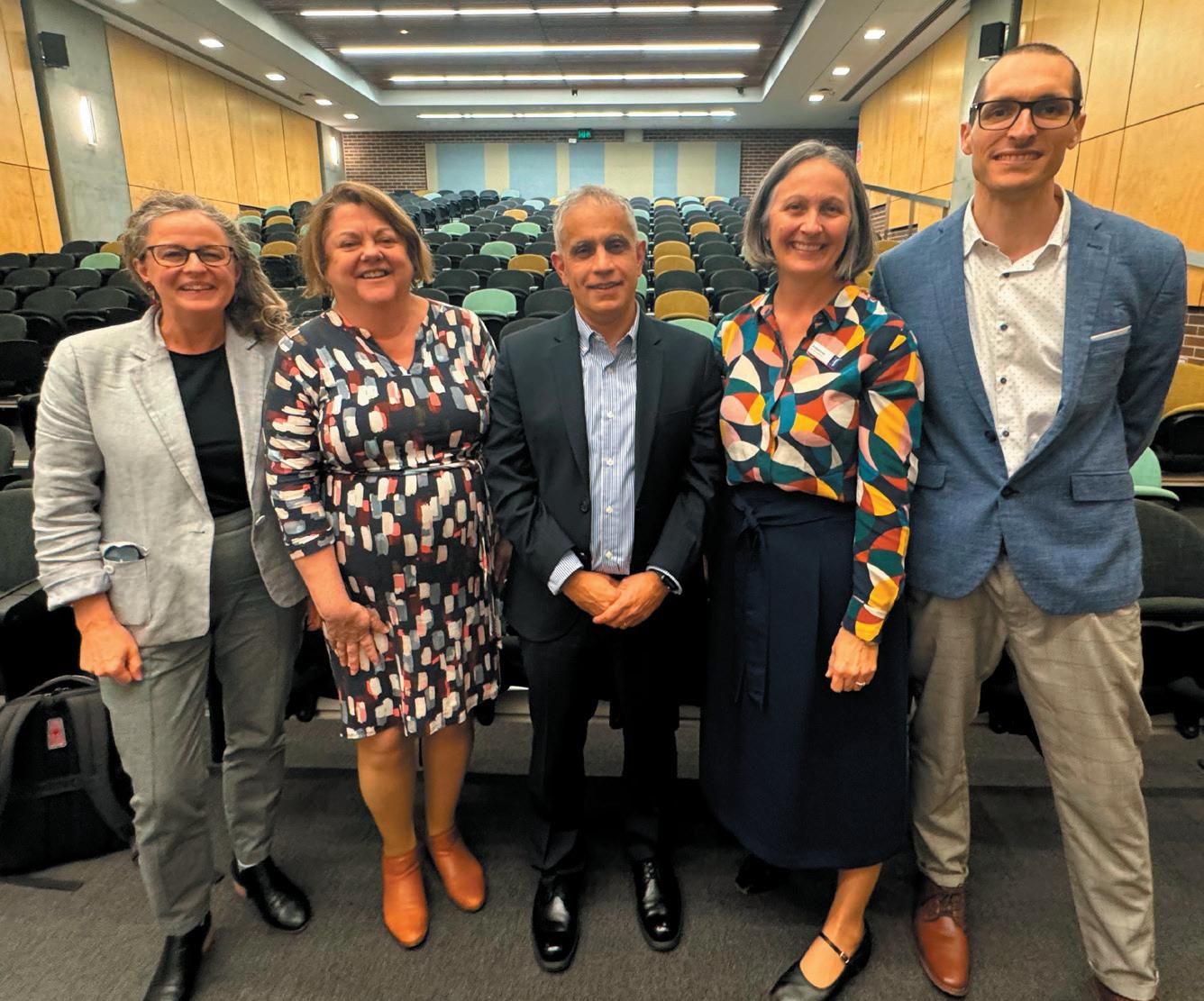
protective mental health layers as children enter adolescence.
The professional learning session lead by Dr Rowland allowed Pymble teachers to connect directly with an academic researching and publishing in the field, and introduced the concept of service to teachers through an evidence-based, academic lens. The following comments reflect the value staff found in the session:
“Great speaker, really wonderful to see the research and very proud that the Junior School has been focusing on the three elements - to self, to others and to the environment.”
“I loved seeing evidence for what seems like common sense.”
“This session was great. I loved hearing about the research behind the importance of service/volunteering and its impact not only on the world around us but on the wellbeing of those doing the service/volunteering. It was wonderful hearing that what
is being done in the Junior school with the focus on Kindness to self, others and the environment/world is supported by this research too. I would love to work with Bosco more on this and learn more about his research and the implications for Pymble!”
Below is the literature review we constructed on the topic of service which aims to take readers through key aspects of the field and provoke thought about this important topic.
In this case, the review was not part of a larger academic project but, instead, formed the groundwork for the practical task of redefining and extending the philosophical understanding of one of the College’s most important areas – putting care into action through being of service to others.
Many people have anecdotal experience of the benefits of service, such as feeling purposeful, needed and happy. Research shows a range of health and wellness benefits connected to engagement in service and volunteering. This is especially important for children and young people as these benefits have positive impact at the time and into the future. This powerful interconnection establishes cycles whereby people volunteer and give service to others, and benefits are felt by the people giving and receiving the service which impacts the whole community. This brief literature review focuses on social impact, health and academic benefits with a focus on children and young people.
Service connects the individual with the world beyond their immediate
network in potentially significant ways. Service programs can promote a sense of engagement in the community and encourage youth to think about the social implications of their own political roles in society (Kuperminc et al., 2001, 448-9; Delgado 2016; Eccles and Barber, 1999; DeMartini, 1983). This was observed in Yates and Youniss’ (1999) case study in which secondary school students were involved in a year-long service program. The participants reported that the service not only exposed them to the lived experiences of others, but also provided opportunities to reflect on their own role in society. The researchers observed that, following the experience, ‘students believed that government policies and actions had a tangible impact on their lives, and they debated these policies with concern and confidence’ (Yates & Youniss, 1999, 510; Delgado, 2016, 173-4). Indeed, it seems participants

in service can emerge from the experience more engaged with the world around them and recognise their ability to function as agents for change.
Research suggests that significant psychological and emotional benefits are strongly associated with young people’s acts of giving service to the community (DeMartini, 1983; Glancy et al., 1986; Moore and Allen, 1996; Youniss et al., 1997; Rowland et al., 2023). Prosocial behaviours are associated with increased resilience and are negatively correlated with clinical depression in young people (Eli et al., 2021; Rowland & EvansWhipp, 2023). Such benefits can be seen in Kuperminc, Holditch and Allen’s (2001, 451-455) analyses of a range of cross sectional and longitudinal studies which found that adolescents involved in service are less likely to be involved with risky behaviours and that ‘psychological well being, empathy, and prosocial attitudes’ are strengthened (Moore & Allen, 1996; Kuperminc et al., 2001, 451; Eisenberg et al., 2014, 67-8). Significantly, early involvement with service provides pronounced and long-lasting benefits. When young people are involved in service before the age of thirteen, the likelihood of clinical levels of emotional symptoms two years later are reduced by approximately 28 per cent (Rowland & Evans-Whipp, 2023, 6). It is observed that service can provide a ‘preventative approach’ to mental illnesses: essentially a protective
component for supporting mental wellbeing in adolescence (Kuperminc et al., 2001, 455; Larson, 1994; Eccles and Barber, 1999).
Studies suggest a protective relationship between prosocial activities such as volunteering and physical outcomes for young people over the long term. The findings of randomised controlled trials show that weekly volunteering can improve cholesterol levels and reduce potentially harmful inflammation and obesity. Researchers observe that young people who engage in volunteering, ‘not only help others, but also benefit themselves, suggesting a novel way to improve health while simultaneously making positive contributions to society’ (Evans-Whipp & Gasser, 2018, 122; Moreno et al., 2013, 400; Schreier et al., 2013, 330). This supports previous observational studies which have established that giving to others functions more broadly as a statistically significant predictor of longevity (Brown et al., 2003).
Academic success of young people appears to be positively impacted by service (Lamborn et al. 1992; Newmann et al., 1992; Kuperminc, 2001). Kuperminc, Holditch and Allen (2001, 449) observe that Year 10 students involved in service, ‘had better academic performance and reported less involvement in problem behaviors in 12th Grade’ (see also Eccles & Barber, 1999; Moore & Allen, 1996). Elder and Conger (2000, 158-9) found that service encourages a range of qualities which appear to contribute to academic success, such as ‘hard work, responsibility, and integrity’. The interconnectedness of service appears to pay dividends, with participants not only provided with more opportunities to engage but, significantly, the ‘belief in their ability to build upon them’ (Elder & Conger, 2000, 159). Longitudinal studies indicate this has long term benefits for academic success into early adulthood (Moorfoot et al., 2015). The emotional and psychological benefits of service appear to pave the way for academic success.
The multitudinal impacts of service work to positively impact different stages of life, through improving social, emotional, and physical health, as well as academic success. The literature indicate that a combined approach of engaging in academic learning, as well as physical activities, alongside opportunities for engaging in service for others can be a significant benefit in the lives of children and young people. Volunteering and service opportunities provide individuals and schools with ways of building protective safety nets to boost prosocial, and reduce antisocial, behaviours and experiences. It is possible that one type of wellness boosts another, which indicates giving service to others and volunteering within the community can improve educational and wellbeing outcomes for students, while they are giving meaningfully to others.
• Literature reviews are useful in setting the scene before embarking on a specific project.
• They are not solely for academic research projects.
• Knowing how the review will be used is a helpful starting point, but the freedom to explore the literature without an agenda is also important.
• As you read the literature, look for themes that are both familiar and that extend your understanding.
• Organising readings into clear themes assists in covering key sub-topics.
• Searching for authors who both support and challenge the topic extends the usefulness of the review.
• The evidence base established by the literature review connects decision making to contemporary and historical discourse, which furthers understanding.
• An academically rigorous overview of a topic can support a range of projects in a school.
Brown, S.L., Nesse, R.M., Vinokur, A.D., and Smith, D.M. (2003). Providing social support may be more beneficial than receiving it: Results from a prospective study of mortality. Psychological Science, 14 (4), pp. 320-327.
Cresswell, J.W. (2018). Research design: Quantitative, qualitative, and mixed methods approaches. (5th Ed.). Thousand Oaks, CA: SAGE.
Delgado, M. (2016). Community practice and urban youth: Social justice service-learning and civic engagement. Routledge. https://doi. org/10.4324/9781315683485
DeMartini, J. (1983). Social movement participation: Political socialization, generational consciousness, and lasting effects. Youth and Society, 15, 195-223.
Eccles, J.S., and Barber, B.L. (1999). Student Council, volunteering, basketball, or marching band: What kind of extracurricular involvement matters? Journal of Adolescent Research 14 (1), pp.10-43.
Efrat Efron, S., and Ravid, R. (2019). Writing the literature review: A practical guide. London: The Guildford Press.
Eisenberg, N., Hofer, C., Sulik, M. J., & Liew, J. (2014). The development of prosocial moral reasoning and a prosocial orientation in young adulthood: Concurrent and longitudinal correlates. Developmental Psychology, 50(1), 58–70
Elder, G. H., and Conger, R. (2000). Children of the land: Adversity and success in rural America. Chicago: University of Chicago Press.
Eli, B., Zhou, Y., Liang, Y., Cheng, J., Wang, J., Huang, C., and Liu, Z. (2021). Depression in children and adolescents on the QinghaiTibet plateau: Associations with resilience and prosocial behavior. International Journal of Environmental Research and Public Health 18(2), pp. 1–12.
Eccles, J.S., Barber, B.L. (1999) ‘Student Council, volunteering, basketball or marching-band: what kind of extracurricular involvement matters? Journal of Adolescent Research 14, 10-43.
Evans-Whipp, T., & Gasser, C. (2018). Adolescent resilience. Longitudinal Study of Australian Children. Annual Statistical Report Australian Institute of Family Studies. Canberra. https://aifs.gov.au/ sites/default/files/2022-03/5599-adolescent-resilience.pdf
Feak, C. B., Swales, J. M., Swales, J. M., & Feak, C. B. (2000). Telling a research story: Writing a literature review. University of Michigan Press.
Glancy, M., Willits, F. K., and Farrell, P. (1986). Adolescent activities and adult success and happiness: Twenty-four years later. Sociology and Social Research, 70, 242-250.
Hart, C. (2018). Doing a literature review: Releasing the research imagination (2nd edition.). SAGE Publications.
Hysaj, M., Crone, M. R., Kiefte-de Jong, J. C., and Vermeiren, R. R. J. M. (2023). Do parental attachment and prosocial behavior moderate the impairment from depression symptoms in adolescents who seek mental health care? Child and Adolescent Psychiatry and Mental Health 17 (1), pp. 133–133.
Kuperminc, G.P., Holditch P.T., and Allen J.P. (2001). Volunteering and community service in adolescence. Adolescent Medicine, 12 (3), pp. 445–458.
Larson, R. (1994). Youth organizations, hobbies, and sports as developmental contexts. In R. K. Silberiesen & E. Todt (Eds.), Adolescence in context. New York: Springer-Verlag.
Lamborn, S. D., Brown, B. B., Mounts, N. S., and Steinberg, L. (1992). Putting school in perspective: The influence of family, peers, extracurricular participation, and part-time work on academic engagement. In F. M. Newmann (Ed.), Student engagement and achievement in American secondary schools (pp. 153-181). New York: Teachers College Press.
Leite, D. F. B., Padilha, M. A. S., & Cecatti, J. G. (2019). Approaching literature review for academic purposes: The Literature Review Checklist. Clinics (São Paulo, Brazil), 74, 1403–1403.
Lim, W. M., Kumar, S., & Ali, F. (2022). Advancing knowledge through literature reviews: “What”, “why”, and “how to contribute.” The Service Industries Journal, 42(7–8), 481–513.
Memmott-Elison, M. K., Holmgren, H. G., Padilla-Walker, L. M., and Hawkins, A. J. (2020). Associations between prosocial behavior, externalizing behaviors, and internalizing symptoms during adolescence: A meta-analysis. Journal of Adolescence, 80(1), pp. 98–114.
Moore, C., & Allen, J.P. (1996). The effects of volunteering on the young volunteer. Journal of Primary Prevention. (17), pp. 231-58.
Moorfoot, N., Leung, R. K., Toumbourou, J. W., & Catalano, R. F. (2015). The longitudinal effects of adolescent volunteering on secondary school completion and adult volunteering. International Journal of Developmental Sciences, 9(3–4), pp. 115–123.
Newmann, F. M., Wehlage, G. G., and Lamborn, S. D. (1992). The significance and sources of student engagement. In F. M. Newmann (Ed.), Student engagement and achievement in American secondary schools. (pp. 11-39). New York: Teachers College Press.
Paul, J., & Barari, M. (2022). Meta analysis and traditional systematic literature reviews—What, why, when, where, and how? Psychology & Marketing, 39(6), 1099–1115.
Phelps, R., Fisher, K., and Ellis, A. (2007). Organizing and managing your research. SAGE Publications, Ltd, https://doi. org/10.4135/9781849209540.
Rowland, B. and Evans-Whipp, T. (2023), Prosocial behaviours and the positive impact on mental Health, Growing Up in Australia: The Longitudinal Study of Australian Children (LSAC). Snapshot Series, Issue 9, pp.1-8.
Rowland, B.C., Mohebbi, M., Kelly, A.B., Benstead, M.L., Herde, J.A., Clancy, E.M., Bailey, J.A., Hallam, B., Sharkey, P., Horner, R., and Toumbourou, J.W. (2023). School influences on adolescent depression: A 6 Year longitudinal study among Catholic, Government and Independent Schools, Journal of Religion and Health, 62, pp. 1136–1156.
Yates, M. and Youniss, J. (1999). Community service and political identity development in adolescence. Journal of Social Issues (54), 3, 495-512.
Youniss, J., McLellan, J. A., and Yates, M., (1997). What we know about engendering civic identity. American Behavioral Scientist, 40, 619-630.

Kate Brown, Head of Junior School, Pymble Ladies’ College
INTRODUCTION
Jacinda Ardern made global headlines on 26 October 2017, when she became New Zealand’s youngest leader since 1856 and the world’s youngest female head of government at the age of 37. Ardern promised that her government would have empathy and be strong. Throughout her time in office, Ardern faced criticism for her empathetic approach to leadership and, in answering those critics, challenged the notion that compassion and strength were binary opposites, saying;
“One of the criticisms I’ve faced over the years is that I’m not aggressive enough or assertive enough, or maybe somehow, because I’m empathetic, it means I’m weak. I totally rebel against that. I refuse to believe that you cannot be both compassionate and strong.”
Anthony Albanese, Prime Minister of Australia, acknowledged the leadership of Jacinda Ardern when she announced her resignation from her role, saying that she “showed us all that kindness and strength are not mutually exclusive. Even more importantly, she has shown
that a true leader possesses both.” (Albanese, 2023).
Kindness is considered a virtue within people’s characters in both Eastern and Western philosophical traditions, yet kindness is often labelled a soft skill which diminishes its potential impact. Kindness is not a soft skill. Kindness should, I believe, be redefined as a strong skill, as simple, regular acts of kindness have significant impacts on both the recipient and the giver. At Pymble Ladies’ College, we aim to prepare students to be influential and compassionate women who
“How can the College enable students to engage with meaningful service projects which support the community and grow their sense of compassion and influence?”
are effective change makers in their world. This is why growing a kindness mindset in our students is so important, and why, as a College, we link kindness with a focus on engaging in prosocial behaviours and doing acts of service. This reflective article explores the ‘why’, ‘what’, and ‘what next’ of service initiatives in the Pymble Ladies’ College Junior School and highlights the transformative experiences of students who engaged in acts of community service.
Kindness grows communities, and it’s clear Junior School students want, and expect, to do more to support the wider community. It is impressive to see how hungry our girls are to lead the change they want to see in the world. The focus on kindness to others has inspired a strong call to action and sense of purpose in the girls, along with a sense of determination to lead change.
“I think we should take robotics into other areas of the community; aged care and indigenous and remote communities.” - Year 6 student, 2024.
“I think we should do whole school initiatives; not just donating money but doing actual things to help our community.” - Year 6 student, 2024.
The question, therefore, is how can the College enable students to engage with meaningful service projects which support the community and grow their sense of compassion and influence?
As our focus on being a Junior School
community of kindness has grown over the last five years, so has the commitment to fostering a service mindset. Across Kindergarten to Year 6, we are teaching our girls that each of us has the capacity to change the world through acts of kindness. Interestingly, whilst being of service is grounded in kindness to others, we have found also that committing to acts of service within the community has had a transformative impact on girls and staff.
“We need to ensure that it does not become tokenistic and that it is part of our values system.” – Year 6 student, 2024.
Living our College values of care, courage, integrity, respect and responsibility every day is critical. How, therefore, do we connect a purposeful focus on kindness with our College values? A challenge question could be posed as to why focus on kindness, when one of our College values is care? Within the Junior School, we focus on kindness as ‘kind’ and ‘kindness’ are words readily used by young children. These words build a focus on kindness to self, others and the environment and foster an understanding of how we can live our College values.
‘Kindness links to our College values because by showing kindness you respect others’ boundaries and have the courage to voice your own boundaries. Being kind means taking responsibility and standing up for your friends and caring for peers in difficult situations. Being kind to
others means having the integrity not to talk behind other’s backs.’ – Year 6 student, 2024.
“Kindness links to our College values because we care for our beautiful school and give others help when they really need it.” – Year 3 student, 2024.
“Kindness links to integrity by committing to the truth. It also links to courage as to be kind to others, yourself and the environment takes strength of character.” – Year 6 student, 2024.
This literature reviewed in this section has been co-written with Sarah Loch, Director - Pymble Institute.
The literature reveals that kindness differs slightly from care as care involves one person giving care to another for a purpose, typically because the other person is in need of this type of support. There are also designated roles of carer and caredfor which connote a power imbalance between the people taking these roles, including teacher and student and parent and child (Noddings, 2012). Malti (2021) highlights the ethical state of kindness, asserting it encompasses both benevolence and gentleness, directed towards others and/or the self.
A focus on kindness is a focus on developing empathy and a compassionate mindset, learning to treat others with warmth and respect. Care involves taking action to ensure the wellbeing of others. One explanation of kindness is that it ‘reflects a particular sensitivity
for others as well as for the self … kindness is a considerate stance towards life, which creates meaning and purpose. It involves a deep concern (i.e. compassion) for both others and the self and, as such, reflects an appreciation of the dignity of every human being’ (Malti, 2021, p. 631).
In my role as Head of Junior School, the important questions I consider are how can we live our values every day and how can I help equip young people with an authentic social conscience alongside the time constraints of curriculum, the school day and busy life schedules without burn out and tokenistic service moments?
In the dynamic landscape of our rapidly changing world, characterised by unprecedented connectivity and technological advancements, the significance of community takes on a new dimension. While technology has undoubtedly facilitated global connections, it has brought about a paradoxical increase in loneliness and isolation, particularly amongst the elderly population. Data issued by the Australian Human Rights Commission (2024) evidences that Australia is getting older and, by 2026, it is estimated that more than 22% of Australians will be over 65 years, an
increase of 6% from 2020 and a 14% increase from the 1970s. The Age Discrimination Act (2004) legislates the need to treat people fairly, regardless of age, and highlights the need to tackle negative stereotypes that lead to age discrimination. Community elders can play a key role in building healthy communities yet can often be overlooked and socially excluded.
Antonio Guterres (2024), Secretary General of the United Nations issued a call to action in 2024 citing the ‘need for peace in all its dimensions…a global need for inclusivity, justice and balance because our world cannot afford to wait.’ As our young people navigate this changing world, it becomes imperative to emphasise the role of community service in combating social disconnect and fostering meaningful human connections. Virtual interactions often replace face-to-face conversations and a survey conducted by the Aged Care Research and Industry Innovation Australia (ARIIA) in 2022, revealed the concerning statistic that one in five older Australians are socially isolated, increasing to one in three who live in aged care. Community service offers a possible antidote to the prevalence of loneliness in our elderly population. As our population ages, there is a growing need for meaningful engagement
“Displaying kindness and engaging in acts of community service both stem from a desire to positively impact someone else’s day. The hope is that an active focus on service learning will take a further step by encouraging empathy and compassion and empowering a call to action amongst students’ learning outcomes which will grow with them as they develop independence and influence.”
between different age groups to combat ageism and foster mutual respect and community cohesion. By connecting with the elderly through conversation and shared activities, students gain a deeper appreciation for the experiences, wisdom and contributions played in our society by older generations, thereby challenging stereotypes and promoting inclusivity. These experiences benefit the recipients but also provide invaluable opportunities for self-reflection, a sense of voice, hope and personal growth in the giver.
Being ‘of service’ and ‘undertaking service learning’ are distinct, yet interconnected, concepts that drive our commitment to community engagement. Being of service involves giving time, effort, and expertise to benefit others. Service learning, on the other hand, integrates service with academic learning, providing students with a comprehensive and experiential education. At this stage within the Junior School our focus has been on embedding community service. Displaying kindness and engaging in acts of community service both stem from a desire to positively impact someone else’s day. The hope is that an active focus on service learning will take a further step by encouraging empathy and compassion and empowering a call to action amongst students’ learning outcomes which will grow with them as they develop independence and influence.
Research shows a range of health and wellness benefits connected to engagement in service and volunteering. There is potential to expand these benefits by including service in the curriculum and thus
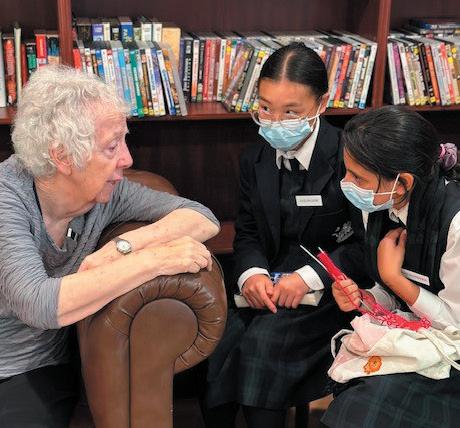

ensuring every student has structured and intentional opportunities. This is especially important for children and young people as these benefits have positive impacts at the time and into the future. This powerful interconnection establishes cycles whereby people volunteer and give service to others, and benefits are felt by the people giving and receiving the service which impacts the whole community. Research suggests that significant psychological and emotional benefits are strongly associated with young people’s acts of giving service to the community (Rowland et al., 2023). Prosocial behaviours are associated with increased resilience and are negatively correlated with clinical depression in young people (Eli et al., 2021; Rowland & Evans-Whipp, 2023).
Service connects the individual with the world beyond their immediate network in potentially significant ways. Service programs can promote a sense of engagement in the community and encourage youth to think about the social implications of their own political roles in society (Kuperminc et al., 2001, p. 448-9).
Each year in Term 2, as we focus on kindness to others, students from Kindergarten to Year 6 are given a Service Journal with ideas for simple acts of service they can undertake around her home and local area. In 2023, Junior School students completed 1000 acts of service across the nine week term and, in 2024, students completed 3000 acts of service (these figures note slight increase in enrolments of students over the past twelve months). Students and staff are encouraged to reflect on the impact they feel those acts of service had on them personally. Thinking about what they have done and why gives students the opportunity to think about how their actions make others feel, even if they never see the beneficiary of their service acts. This fosters a compassionate, kind mindset and helps to build a commitment to care. The provocation of ‘what does service mean to you’ was given to students in their service journals and students and staff were invited to write or draw their response. These comments reflect the impact being of service has on the giver; developing a sense of giving
for giving sake and fostering an understanding as to how service shapes character and builds a sense of connection to your local community. The following quotes are taken from student and staff service journals over the last two years.
“Helping at home makes me feel good as I make my family happy.” – Year 2 student, 2024
“Being of service made me feel courageous as I did things I don’t normally do. It also made me feel thoughtful and helpful.” – Year 4 student, 2024
“Being of service helped me give back to my community and made me feel proud of my actions and behaviour. Being of service led me to feeling more positive about myself which, in turn, led me to do even more acts of service.” – Year 5 student, 2024
“Being of service means giving time to others without the need for recognition.” – Year 6 student, 2023
“Being of service should be integrated as part of our character, giving of

ourselves, of our time, talents, energy and happiness to those around us. Often being of service invites everyone to extend a part of who they are to a broader community through initiatives but to me, being of service starts with those closest to me – family, grandparents, extended family and neighbours.” – Teacher and leader of aged care service initiative, 2024
Over the last three years, the Junior School has partnered with Uniting Care to establish relationships with aged-care facilities, including Bowden Brae, North Haven and Kari Court, all located in the local area. Students regularly visit these care facilities as acts of community service to help reduce the loneliness felt by these elders in our community, many of whom have no regular visitors. During these visits, simple conversations, musical performances and shared craft and technology activities between students and residents promote intergenerational connections and we have found these visits have a positive impact on
both the elders and the girls. These regular connections with aged care facilities during the school day are a step towards the culture we seek to nurture across the College and a step towards the world girls like Trisha, Year 6, 2024, hope we can together create as they are relationship building rather than one of moments of service. As we strive to educate compassionate and influential students we hope that students will develop the intrinsic motivation to connect with the community outside of school hours and encourage members of the family to follow suit, thereby building a wave of prosocial behaviour.
Given the passion for robotics within our Junior School, we connected with St Lucy’s School, Wahroonga which caters for primary aged students with complex learning needs. The aim of our visits is to help grow basic robotic skills in the Year 5 students at that school. The Pymble students ventured beyond their own robotics learning as they stepped into the role of educators and passionately shared their knowledge with the St Lucy’s students. The girls
faced challenges in communicating with non-verbal peers, requiring calmness, agility and creativity. The experience pushed our students outside their comfort zone, fostering a sense of maturity beyond their years. The girls found the service transformative, emphasising the deep sense of gratitude and connection forged with their buddies and each other.
“I knew that service benefits other people, but I think it benefited me as well. My buddy was less verbal, so I had to work hard to learn how to communicate with him in different ways. I am now a more openminded person and it’s easier for me to make friends.” – Year 6 student, 2024
Each week, I receive letters via our Junior School postbox from girls sharing their thoughts, questions and ideas. What has surprised me over the last two years has been the increasing number of initiatives Junior School girls are determined to lead. Jasmine Smith, Year 4, 2024, approached me with a community service idea, Cook2Care aimed
at encouraging others to donate cooked meals and non-perishable foods to support the homeless and those facing financial hardships. Jasmine has so far inspired over 400 donations of meals and nonperishables which have been shared across eight Uniting Care shelters and The Dish of St John’s, Wahroonga.
During a service visit to The Dish to deliver meals prepared by their families, Year 3 and 4 students heard how there is often a lack of fresh fruit and vegetables available for local families with young children. A small group of Year 3 girls subsequently approached me with an idea to encourage each Junior School girl to bring in one piece of fruit/vegetable on a Monday which can then be delivered that day to The Dish for the benefit of the families who use that service. It is evident that Jasmine’s initiative is growing momentum across our Junior School and it continues to positively impact families in our community. One child,
one voice and a huge social impact.
Prosocial behaviours, including community service provide a tangible way for young people to address the adverse effects fast paced modern life can have on social well-being. By actively participating in initiatives that promote human connection and community cohesion, students learn to prioritise authentic relationships over online interactions. They learn to appreciate the impact of simple acts of kindness. Research into the impact of community service on the development of social skills in students conducted by Afzal (2020) cites the work of psychologist, Lawrence Kohlberg (1971), who defined community service as a ‘vital element of social and civic development that forces students to confront social issues’. He believes that when people engage in services for others, they inevitably gain new perspectives and subsequently capacity reasoning at higher levels

by reorganising the way they think about a given situation. Prosocial behaviours are also developed when people engage in intentional situations in their community which allow them to be of service and to work alongside others in the task (Bond & Smith, 1996).
When specific situations or settings are established, letting individuals serve the society and work collectively with each other, prosocial behaviours progress more voluntarily, which expand the overall setting of other relationships in the community (Bond & Smith, 1996).
Recognition for our service through Uniting Care earned a group of Junior School girls and Mrs Nerissa Davey, former Deputy Head of Junior School Operations, who initiated the partnership, a national volunteering award in 2023. Wonderful as it is to be recognised for our service, the authentic human connections forged through shared experiences are even more treasured by those involved.

“In giving, we receive. In a world caught up in ‘receiving’, going back to a focus on giving and caring for others is energising and fulfilling.”
– Nerissa Davey, former Deputy Head of Junior School Operations and leader of Bowden
Brae Service Initiative.
“I have learnt that if you help, support or even just listen to others, you can encourage other people to do the same thing. Hopefully one day the whole world will learn how important it is to be of service.” – Year 6 student, 2023
“Through the service I have done, I have learnt to be more confident, and this has enabled me to make new friends so I ended up learning so much about myself as well as learning about, and with, my buddy.” – Year 6 student, 2024
Opportunities to engage in acts of service provide students with real world experiences that broaden their perspectives and cultivate a deep understanding of others. Through service, schools such as Pymble aspire to nurture well-rounded individuals who excel academically, contribute positively to society and
to building a cohesive community.
The girls have been honest in their feedback on where to next. Having heard from them directly through focus groups over the last twelve months and reading their survey feedback, we have taken direct steps to strengthen our service commitment in the Junior School. I am drawn back to the comment made by one of the Year 6 students who in a feedback survey advocated for the implementation of whole school initiatives to assist the community.
So, what are we doing next? We are developing a comprehensive Service Continuum from Kindergarten to Year 6, as part of a whole-of-College Service framework, to ensure a progressive and age-appropriate approach to community service.
Asking students for their feedback and listening authentically to their voices is a key part in the process of building our Service Framework which will encourage acts of service initially within the young child’s immediate environment through to partnering with local organisations
in the community. Next year we will redefine the scope of our Junior School Kindness Leaders to include a clear focus on service in their leadership portfolio, thus empowering a strong student service leadership team from Year 1 to Year 6.
Service has emerged as a powerful catalyst for cultivating leadership and fostering a kindness community. The reflections of our girls and staff exemplify the transformative impact of service, emphasising the importance of an open mind, empathy, patience and tenacity in shaping positive social interactions. By nurturing empathy, compassion, and a sense of social responsibility, service initiatives lay the foundation for building resilient, interconnected communities. As educators, it is our collective responsibility to inspire and empower the next generation to harness the transformative power of community service in shaping a more compassionate and inclusive society.
“You give but little when you give of your possessions. It is when you give of yourself that you truly give.” –
Kahlil Gibran
References
Afzal, A. (2020). Impact of community service learning on the social skills of students. Journal of Education and Educational Development 7(1), 55-70. http://dx.doi.org/10.22555/joeed.v7i1.2988)
Albanese, A. (19 January, 2023). Opinion: Jacinda Ardern reminds us that kindness and strength are not mutually exclusive. Sydney Morning Herald. https://www.smh.com.au/world/oceania/jacinda-ardernreminds-us-that-kindness-and-strength-are-not-mutually-exclusive20230119-p5cdz8.html
Australian Bureau of Statistics. (December 2011). Australian Demographic Statistics, June 2011.
Australian Human Rights Commission (2014). Statistics from 2014: Facing the facts (https://humanrights.gov.au/our-work/education/
face-facts-older-australians#:~:text=By%202050%2C%20around%20 one%20quarter,14%20years%20by%20around%202025.)
Kuperminc G.P., Holditch P.T., & Allen J.P. (2001). Volunteering and community service in adolescence. Adolescent Medicine, 12(3), pp. 445–458.
Malti, T. (2021). Kindness: a perspective from developmental psychology. European Journal of Developmental Psychology, 18(5), pp. 629–657. https://doi.org/10.1080/17405629.2020.1837617
Noddings, N. (2012). The language of care ethics. Knowledge Quest, 40(5), 52-56. http://ezproxy.lib.uts.edu.au/login?url=https://wwwproquest-com.ezproxy.lib.uts.edu.au/scholarly-journals/languagecare-ethics/docview/1032543737/se-2

Imogen Kennett, Year 4 Co-ordinator and Classroom Teacher, Pymble Ladies’ College
INTRODUCTION
This year, the Pymble Ladies’ College Junior School embarked on an exciting initiative called ‘Book Bouncing”’ where volunteers drop in to read stories to the girls. It all began with a surprise visit from one of the Senior Executive team who delighted my Year 3 2023 class with an impromptu reading session, sparking a wave of enthusiasm and setting the stage for a program that has since expanded across multiple year groups. As the teacher who first experienced the magic of Book Bouncing, I’ve had the privilege of witnessing firsthand the profound
impact it has on our girls.
This initial visit was an unplanned, delightful surprise. The staff member, Sarah Loch, came armed with one of her son’s cherished picture books and asked if the class had time for a story. What followed was twenty minutes of laughter, wonder and pure joy. From that first visit, it was clear that Book Bouncing was something special. The girls eagerly anticipated Sarah’s visits, which became a regular part of our fortnightly schedule. The books she selected brought stories to life in a way that only a passionate reader
can. Each session was an adventure, a journey into new worlds and an opportunity for the girls to see how stories can ignite imagination and foster a love for reading. [See Figure 1.]
One of the most rewarding aspects of Book Bouncing is how it models the joy and curiosity that come with discovering a new story. Sarah’s expressive reading and genuine delight in the stories serve as a powerful example for the girls. They see firsthand how a story can captivate and entertain, and they learn how to respond with curiosity
and wonder. This aligns with the findings of Senawati et al. (2020), who emphasise that reading aloud to young learners promotes language skills, fosters a love for reading, and provides a foundation for later language development.
As a teacher, I have found Book Bouncing to be an invaluable addition to our literacy program. It complements our classroom activities by providing a fresh voice and a different perspective on storytelling. The girls themselves have expressed how much they love and value the Book Bouncing sessions:
Caia shared, “I like Book Bouncing because Dr Loch uses different expressions. It is important to hear different people read to us so we can hear different voices and tones.”
Avril noted, “I think it is important that we hear people read to us because we can reflect on a new
book and what the story is trying to tell us.”
Muse added, “I like when Dr Loch comes into 4K because she picks amazing books with great illustrations. We always have fun.”
Olivia emphasised, “I like Dr Loch coming into 4K because she reads us stories and she explains a lot about the story. I think other people reading to us is important because we can build our vocabulary and become better writers.”
Evelyn highlighted, “I like when Dr Loch reads to us because her voice is soothing and calming. It makes me feel happy and ready to start my day.”
The benefits of reading aloud to children, as highlighted in the review by Senawati et al. (2020), are manifold. Reading aloud introduces and consolidates vocabulary and sentence structures, encourages
students’ passive vocabulary and exemplifies morality and character education. For young learners, reading is the process of matching the sounds of the language and the written text, providing a good foundation for further reading stages. This perspective is further supported by Ledger and Merga (2020), who emphasise the need for regular reading aloud practices in both school and home settings. Their study highlights children’s positive attitudes toward being read to and suggests that regular read-aloud sessions can foster a lifelong love for reading and potentially mitigate aliteracy.
The success of Book Bouncing has led to its expansion throughout the Junior School. We now have several staff members from various roles within the College participating, each bringing their own unique collection of stories and personal touch to their reading sessions.
Sam Patmore, our library technician,

“The success of Book Bouncing has led to its expansion throughout the Junior School. We now have several staff members from various roles within the College participating, each bringing their own unique collection of stories and personal touch to their reading sessions.”
has embraced this initiative wholeheartedly. This year, she was specifically chosen to conduct her Book Bouncing sessions with a Kindergarten class. Sam’s experience as a parent has honed her skills in reading aloud to younger audiences, making her an ideal fit for engaging with Kindergarten students. Reflecting on her experience, Sam shared, “I have enjoyed seeing the smile on the girls’ faces when I visit and their inquisitive nature. They are a bundle of joy and brighten my day.” She also highlighted the significant impact of reading aloud, noting, “having someone read aloud to the girls is crucial for their development of language skills. Hearing different voices from a variety of people helps children become more inclusive of other cultures and perspectives.”
Kate Murray, the College Archivist, brings a rich and varied background to the program. An enthusiastic reader, Kate was eager to join Book Bouncing because of her love for books and reading to children. She fondly remembers reading to her own children from birth, often sharing books from her own childhood. Kate reads with a Year 4 class every fortnight and describes the joy of being welcomed (See Figure 2) with excitement by the girls, saying, “It’s wonderful to walk into the classroom and hear the girls excitedly exclaim ‘yes!!’ when they see me!” For Kate, Book Bouncing offers a refreshing break from her routine and provides the
girls with a break from their regular schedule. She values the opportunity to contribute to the girls’ learning experiences, bringing her favourite books, such as Julia Donaldson’s Charlie Cook’s Favourite Book, to share with them.
Kate also uses her sessions to introduce her fascinating career to the girls. She shares stories from her work at prestigious institutions like the National Trust, the Australian Museum and the Museums of History. She recounts her diverse experiences, such as working on a 75-million-year-old dinosaur, curating exhibitions at the Hyde Park Barracks and producing a book about the Australian Museum. By doing so, Kate aims to broaden the girls’ horizons and plant seeds of curiosity about various career paths. Her interactive reading sessions are highly engaging, with girls eagerly participating and
responding to questions, making the experience enriching for both the girls and Kate.
Emma Coupland, one of the College’s executive assistants, has had the privilege of reading to a Year 2 class this year. Reflecting on her experience, Emma shared, “the Book Bouncing program has allowed me to read every fortnight to the most beautiful group of girls in Miss Charalambous’ class. It is honestly a highlight of my week, reminding me why I come to work here at Pymble every day - to contribute, in some small way, to the learning opportunities of all Pymble girls. It brings me such joy to see their faces light up at the book I read and the short group discussions we have at the end of reading time.” Emma emphasises the significant impact of reading aloud, saying, “I think one of the biggest positives of reading aloud to the girls is hopefully fostering in them a love of books and reading. I believe it also helps to build their listening skills and provides a time where they can all come together as a group in a calm environment and share in the joy of reading regardless of their abilities.”

The review by Senawati et al. (2020) underscores the importance of reading aloud as a means of enhancing literacy skills. They argue that reading aloud can be the simplest way for young learners to experience literacy, supporting language development and comprehension in a relaxed and enjoyable manner. This perspective aligns perfectly with the objectives and outcomes of our Book Bouncing program, demonstrating its value not only in our school context but also in the broader educational landscape. Additionally, Ledger and Merga (2020) point out the concerningly low frequency of reading aloud practices in Australian classrooms and homes, emphasising the need for regular read-aloud opportunities to foster positive attitudes towards reading and develop students’ literacy skills effectively.
Further supporting this, Håland et al. (2020) highlight the myriad benefits of interactive read-aloud sessions.
These sessions help young readers identify as readers and writers, expanding their sense of belonging to a “literacy club” (Smith, 1988). By participating in read-alouds, children can develop a narrative imagination, gaining insights into others’ lives and emotions (Nussbaum, 2010). This practice also provides cultural capital, allowing students access to varied discourses and fostering a deeper comprehension of texts across subjects like science and social studies (Heisey & Kucan, 2010; Strachan, 2015).
Teachers reading aloud can stimulate literacy development, promoting skills from phonological awareness to understanding story structure and grammar (Mol et al., 2009; Stevens et al., 2010). Interactive readalouds can serve as model texts for students’ writing, helping develop comprehension strategies and vocabulary (Brabham & Lynch-Brown, 2002; Sandoro et al., 2016). By engaging with challenging texts and
Brabham, E. G., & Lynch-Brown, C. (2002). Effects of teachers’ reading-aloud styles on vocabulary acquisition and comprehension of students in the early elementary grades. Journal of Educational Psychology, 94, 465–473.
Håland, A., Hoem, T. F., & McTigue, E. M. (2021). The quantity and quality of teachers’ self-perceptions of read-aloud practices in Norwegian first grade classrooms. Early Childhood Education Journal 49(1), 1–14. https://doi.org/10.1007/s10643-020-01053-5
Heisey, N., & Kucan, L. (2010). Introducing science concepts to primary students through read-alouds: Interactions and multiple texts make the difference. The Reading Teacher, 63(8), 666–676.
Ledger, S., & Merga, M. K. (2018). Reading aloud: Children’s attitudes toward being read to at home and at school. The Australian Journal of Teacher Education, 43(3), 124–139. https://doi.org/10.14221/ ajte.2018v43n3.8
Mol, S. E., Bus, A. G., & de Jong, M. T. (2009). Interactive book reading in early education: A tool to stimulate print knowledge as well as oral language. Review of Educational Research, 79(2), 979–1007.
Nussbaum, M. C. (2010). Not for profit: Why democracy needs the humanities. Princeton: Princeton University Press
high-quality discussions, students can enhance critical thinking and deepen their literacy learning (Shanahan et al., 2010).
The Book Bouncing program not only aligns with but also exemplifies the benefits highlighted by educational research. By fostering a love for reading and providing a rich, interactive reading experience, Book Bouncing supports the girls’ literacy development, emotional wellbeing, and academic growth, ensuring a bright and literate future for them. For me, Book Bouncing is more than just a program, it’s a community effort that highlights the collective commitment of our staff to the educational and emotional wellbeing of the girls. It’s a reminder of the power of stories to connect us, to teach us, and to bring joy into our lives. I am deeply grateful to Sarah Loch for spearheading this initiative and making Book Bouncing a cherished part of the Pymble Junior School culture.
Sandora, C., Santoro, L. E., Baker, S. K., Fien, H., Smith, J. L. M., & Chard, D. J. (2016). Using read-alouds to help struggling readers access and comprehend complex, informational text. Teaching Exceptional Children, 48(6), 282–292.
Senawati, J., Suwastini, N. K. A., Jayantini, I. G. A. S. R., Adnyani, N. L. P. S., & Artini, N. N. (2021). The benefits of reading aloud for children: A review in EFL context. Indonesian Journal of English Education, 1(1), 80–107. https://doi.org/10.15408/ijee.v1i1.19880
Shanahan, T., Callison, K., Carriere, C., Duke, N. K., Pearson, P. D.,Schatschneider, C., & Torgesen, J. (2010). Improving reading comprehension in kindergarten through 3rd grade: A practice guide (NCEE 2010–4038). Washington, DC: National Center for Education Evaluation and Regional Assistance, Institute of Education Sciences, U.S. Department of Education.
Smith, F. (1988). Joining the literacy club. Portsmouth: Heinemann.
Stevens, R. J., Van Meter, P., & Warcholak, N. D. (2010). The effects of explicitly teaching story structure to primary grade children. Journal of Literacy Research, 42, 159–198.
Strachan, S. L. (2015). Kindergarten students’ social studies and literacy learning from interactive read-alouds. Journal of Social Studies Research, 39, 207–233.
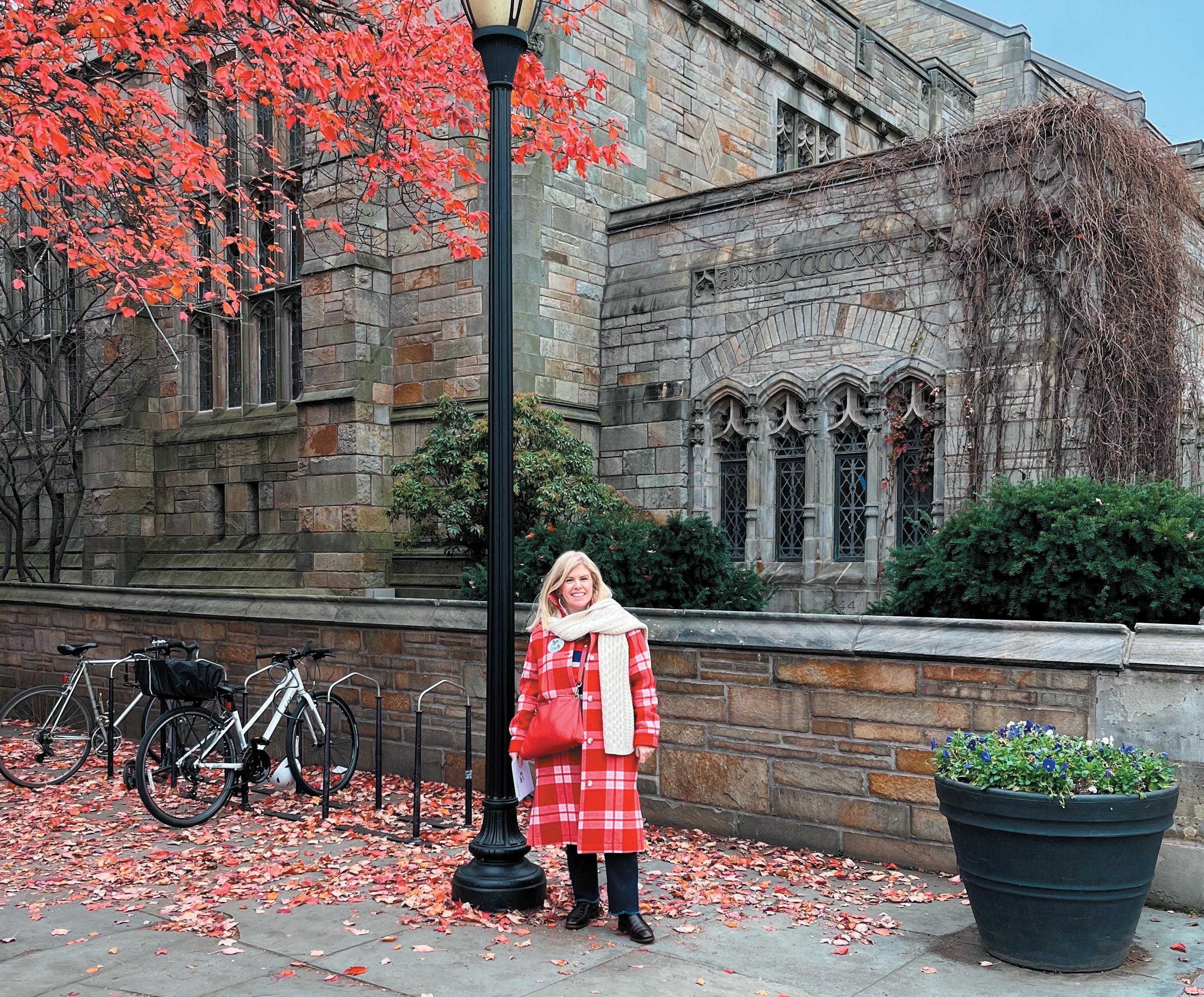
Carolyn Burgess, Director of Boarding, Pymble Ladies’ College
Our families place enormous trust in the College when they enrol their daughters as Boarders at Pymble As a staff, we work hard to deliver exemplary care and outstanding opportunities to honour this trust and staying abreast of best practice in the world of residential care is key to our success. A planned and extensive professional learning program is integral to this endeavour, and I was delighted to be awarded the Kate Mason Professional Learning Grant in 2023 to attend The Association
of Boarding Schools (TABS) Annual Conference and visit a number of international boarding schools.
HELLO EMMA!
After much research and a focused brief, I set off for the United States on November 6 2023. My first stop was Emma Willard, a boarding school established in 1814 and set on 137 beautiful acres in upstate New York. With a theme of ‘Find your voice here, then use it to serve and shape the world’, and an enrolment of 356
students, including fifty boarders, the school felt very aligned with Pymble in vision, if not student numbers. With a deep-rooted history of more than two hundred years, it is easy to understand the importance of tradition at the school. One of my favourite rituals was the recognition of the longest-serving staff member in a ceremony called the ‘Wearer of the Red Hat’. This staff member leads the academic processions for the start, middle and end of term. Perhaps the biggest incentive for this
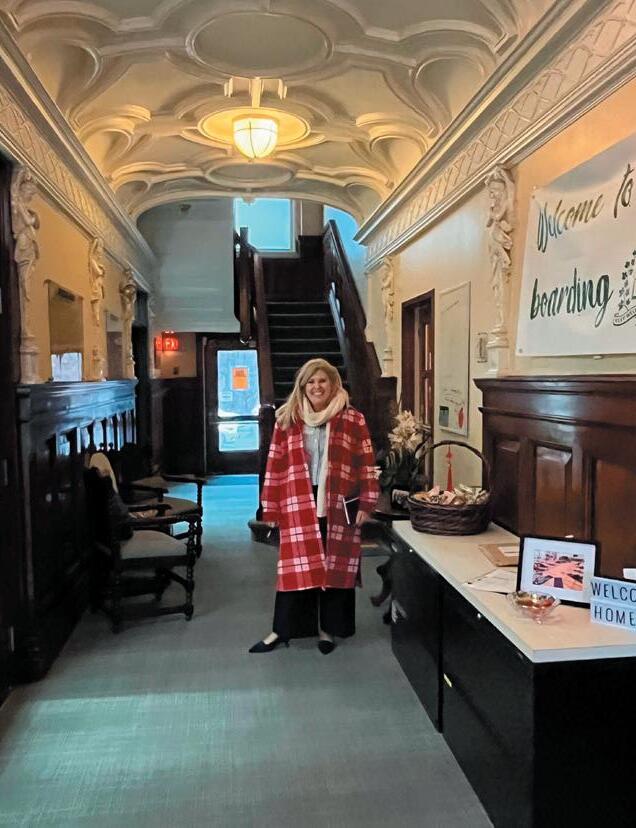
award (for Pymble staff, at least) is the gift of a dedicated parking space! There is also an annual senior play, tea ceremonies and ring gifting, all of which hold a long and treasured history for the staff and students.
A few hours away, heading Southeast, I visited Miss Porter’s School in Farmington, Connecticut. Established 1843 and set on 55 acres, Miss Porter’s calls their students to “shape a changing world”. This was evident in a strong focus on international studies in an interdisciplinary curriculum and a culture of giving back. Like Emma Willard, the school has a relatively small population of 336 students but with a booming boarding community of 213. With the high ratio of boarders to day students, the school was very much focused on residential life. The boarders live across five houses, and it was interesting to unpack their move from a horizontal to a vertical structure just as we were planning, and have now implemented, for our Pymble Boarding family. I was delighted to hear how successful the change had been and keen to implement some of their initiatives.

Between 15 and 17 November, I was fully immersed in the TABS Annual Conference which was held in Boston, Massachusetts. This was a wonderful opportunity to connect with boarding staff from around the United States and Canada, with over 500 delegates attending. There were a host of opportunities to learn, including the following breakout sessions which I attended:
• Building cultures of mental wellness: Strategic approaches to supporting mental health
• When students thrive: Strategies that promote student mental health in boarding schools
• How collaboration creates champions
• Design matters: Creating spaces and places for belonging
• The cultural carriers of the school: What can boarding schools do to empower, equip and deploy the senior class?
• Anticipating and preparing for student crises in a boarding school
• Rethinking the triple threat –building a house for staff and student thriving
• Preventing intense homesickness at boarding schools
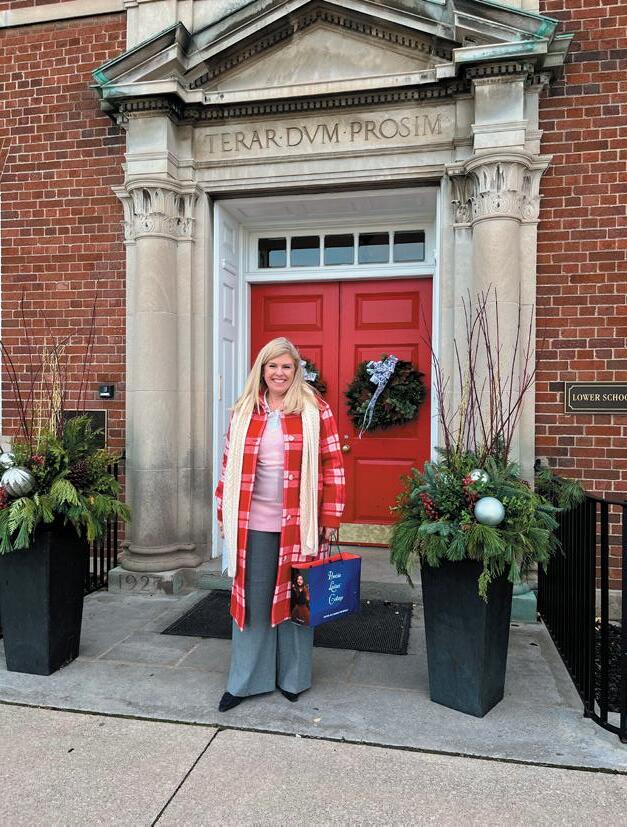
One of the most interesting keynote speakers was David Oh, PhD, Principal Systems Engineer at NASA’s Jet Propulsion Laboratory, who spoke of his journey “From Dorm Rooms to Mars Dunes: Reflections on a Boarding School Launchpad to Space Exploration.” It was both fascinating and affirming to hear of the opportunities and dispositions that David’s time at boarding school afforded him and how these were directly related to his future career. Sneaking into the science laboratories after lights out is perhaps one of his highlights which I will not be sharing widely with our boarders!
Following the TABS Conference, I travelled to Canada to visit more boarding schools, starting with Ridley College, situated on ninety acres in the Niagara region. A co-educational college, founded in 1889, Ridley is home to 375 boarders in addition to 415 day students. With more than fifty eight countries represented, the opportunity to attend school “with the world” and prepare for a life of leadership and impact is high on the agenda. An authentic sense of belonging is fostered through a strong boarding culture with every “Ridleian”, day and boarding,
belonging to one of ten boarding houses. Each of the houses has its own unique personality - mascot, chants, colours, traditions and history - and this has given me much thought about how such an arrangement might enhance our boarding culture.
Travelling on to Toronto, I visited Branksome Hall and Havergal College, founded in 1903 and 1894 respectively. Both schools were home to around 1000 students, each with a boarding community of around fifty. It was interesting to compare the facilities, routines and opportunities available for boarders and I enjoyed the opportunity to meet with boarding students and hear of their experiences. For all of them, it was the plethora of opportunities, including an outstanding education and entry to prestigious universities, along with the camaraderie that is part and parcel of boarding life, that were standout gifts.
In between these destinations I visited Yale and Harvard Universities, along with a number of museums, and learnt much along the way. From the allocations of roommates, to the organisation of dining, to the strong traditions and extensive alumni that unite residential communities, there was much valuable learning and opportunities I hope to use to enrich the experience for our Pymble Boarding family.
THE BENEFITS OF PROFESSIONAL LEARNING IN A GLOBAL CONTEXT: Q&A WITH CAROLYN
When you reflect on Pymble Boarding, what can you now see in a new light?
While I have always recognised the
benefits of a Pymble education and the strengths of our Boarding family, there is nothing like stepping away to reassess and reflect. My international boarding tour was both enlightening and affirming.
It is easy to overlook the power of context and undertaking this research reinforced in me the undeniable impact of geography and population on the boarding setting. With more than 80 per cent of our Pymble Boarders joining us from rural and remote locations, they come seeking opportunities that are just not available within a reasonable distance of their homes. Subject choice, specialist teachers, sporting options and social engagement are top of the agenda for our families who choose Pymble and this reinforces the importance of our Live It, Love It, Learn It program. By contrast, students of more heavily populated and less decentralised countries, such as the United States and Canada, have greater opportunities to access this type of education close to home, hence the relatively low level of domestic verses international students at the schools I visited. The main motivation for enrolment, at least at the girls’ schools I visited, appeared to be the resources available to support entry to an American university. This was evidenced in the college entry programs, dedicated college counsellors, strong emphasis on clubs and societies and the focus on leadership.
While four of the boarding schools I visited were limited to Year 9 to 12 students, the level of supervision and care provided was significantly different. Staff were not on duty until 5.00pm, while boarding houses were open during the day for all
students. While most staff lived on site, care of the boarders was just another aspect of their roles – they were also committed to teaching and co-curricular responsibilities. As was reinforced at the TABS conference, the ‘triple threat’ – where staff hold three significant responsibilities, was very real and one which could be challenging to manage. At Pymble we are fortunate to have staff who are specialists in around-the-clock residential care, and this is their only responsibility. After observing, discussing and listening, I am convinced that Pymble is employing the right staffing model for the optimum experience for our Boarders and the wellbeing of our staff.
In terms of professional learning, what was a highlight of this trip for you?
Meeting others - peers and students reaffirmed my appreciation of all that we have at Pymble. The experience confirmed my view that we certainly do offer a world class education, and we are effectively (and joyously!) meeting the needs of our families, in the unique context of Australia. There were both formal and informal conversations and many occasions for observation and reflection to support this view.
There were, however, many opportunities to learn and I have returned with ideas to enhance and extend our Boarding program. Little tweaks such as the addition of new traditions, improved leadership training, and better ways to build alumni relations are already underway. A more informed view of the enrolment and giving processes is evolving and I hope to share insights more widely with my colleagues.
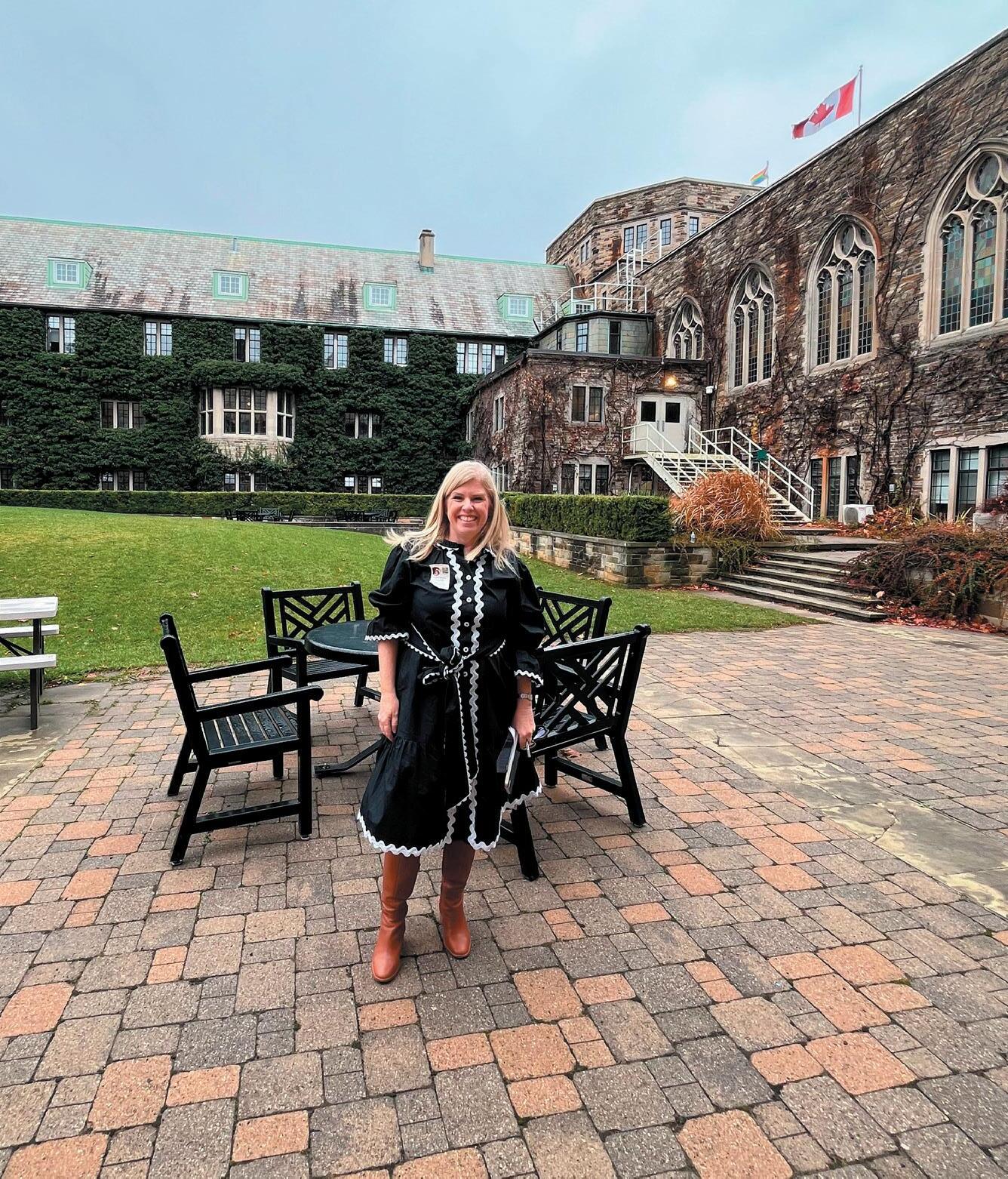
Opportunities for international exchanges for both Boarders and staff are in their fledgling stages, but I am hopeful that these will be set in place, allowing others in our community to benefit from an international perspective and the opportunity to reflect with perspective.
Professional learning for leaders in boarding can be challenging because the role is very busy across the whole term. What do you recommend in terms of opportunities to help boarding staff grow in their roles?
Boarding and caring for other people’s children is a role in which there is no ‘off’ switch – at least during term time. Term breaks are important times to recalibrate, switch
off and complete unincumbered professional learning, The opportunity to take a block of time, in a clear space, where you are not on call or in major recuperation mode, is an incredibly valuable and highly recommended.
I am grateful that the College has recognised this need for within the Boarding faculty whose needs can be considered niche. Not only does this time and space allow for professional growth for staff and the associated benefits for those in their care, it also sends a clear message that boarding is a professional career which requires investment in credentialling.
What sort of global perspectives did you have the opportunity to explore?
It was interesting to compare the three different education systems and the outcomes for students. While the Canadian and Australian systems seem very much aligned with the school career culminating in final, externally imposed examinations, the final year in the American schools seems to be one of celebration and joy. The American students I met had worked hard over the previous three years to gain the required credit points and were enjoying the opportunity to network, develop areas of interest and make the most of all that was on offer in their final year at school. Whether it be joining the senior play, leading a club of interest or collaborating on a handson project, the aim was preparing for life beyond school. This freedom, fruition, fun and fraternity could be enhanced for our students and the associated outcomes of increased confidence, connection and creativity are opportunities worthy of further exploration.
My deep gratitude goes to the College for this wonderful opportunity to grow and learn. I will continue to work with the Boarding team to increase the development of character, resilience and optimism amongst our Boarders, build a strong sense of identity and provide life changing opportunities. I am particularly keen to harness the knowledge and experiences of our wonderful alumni. There are many ideas that I will borrow and develop, to ensure Pymble Boarding continues to provide exemplary care for our Boarders while developing courageous, caring, respectful, responsible young women of integrity who will go on to change their world.
